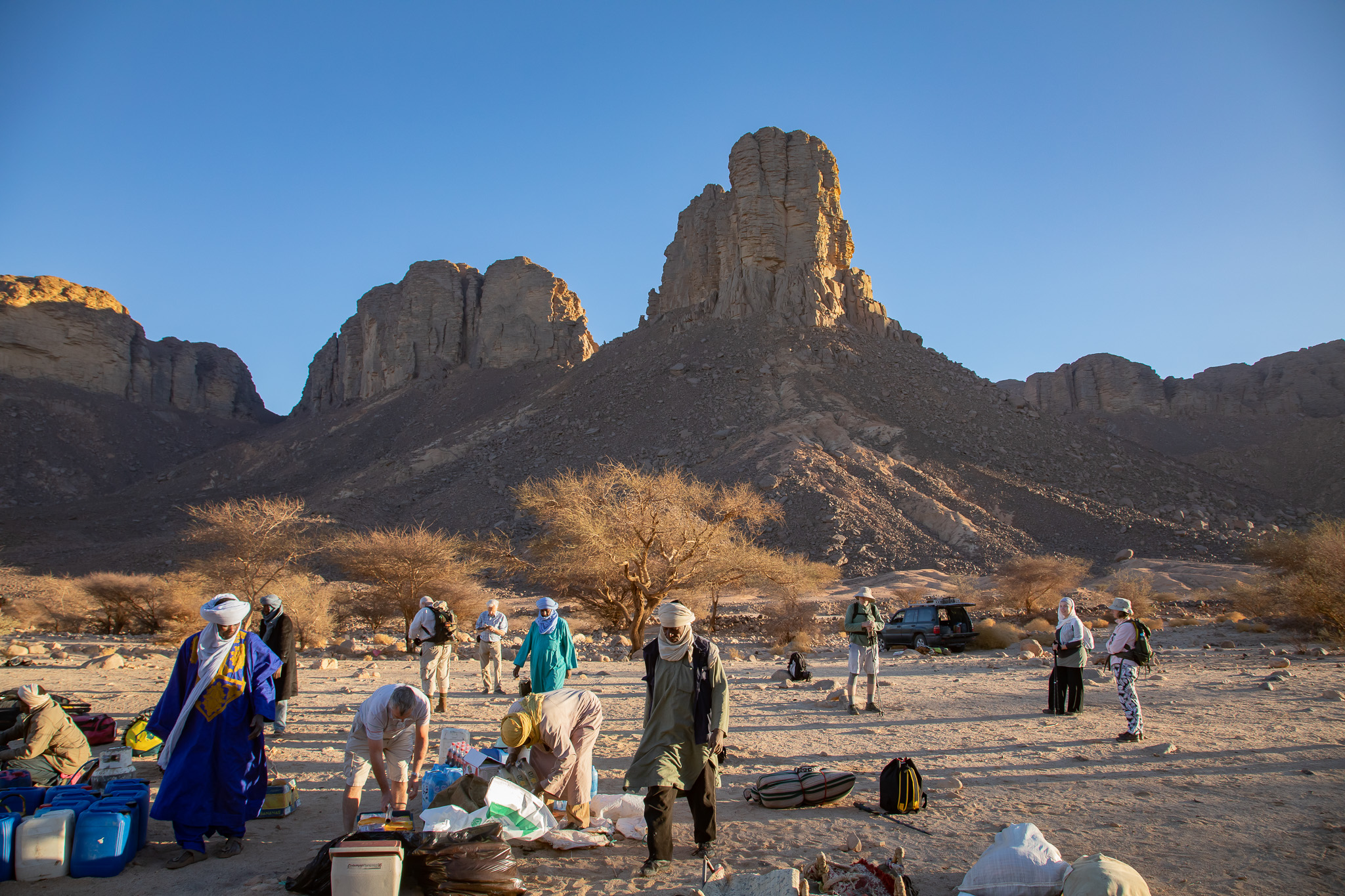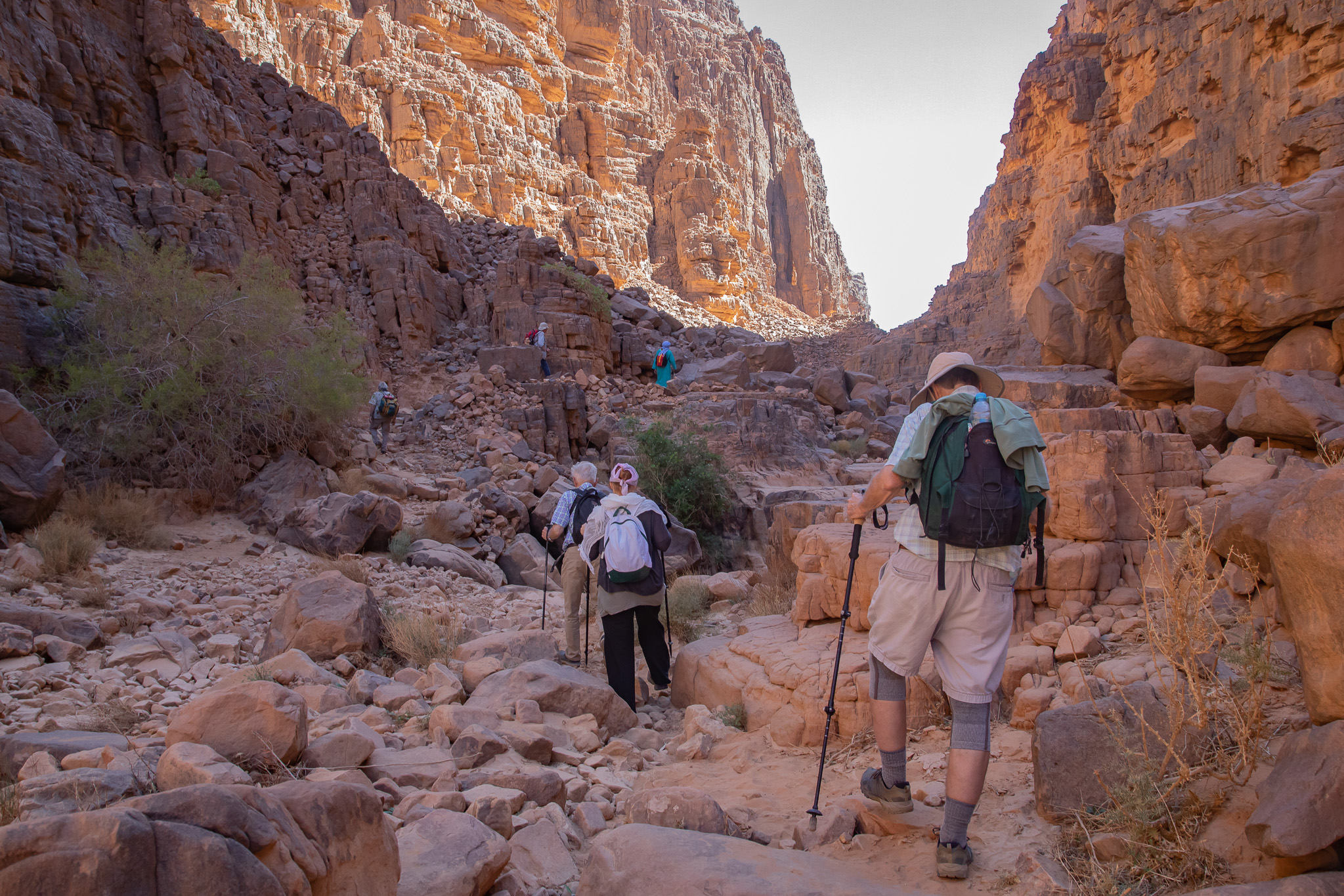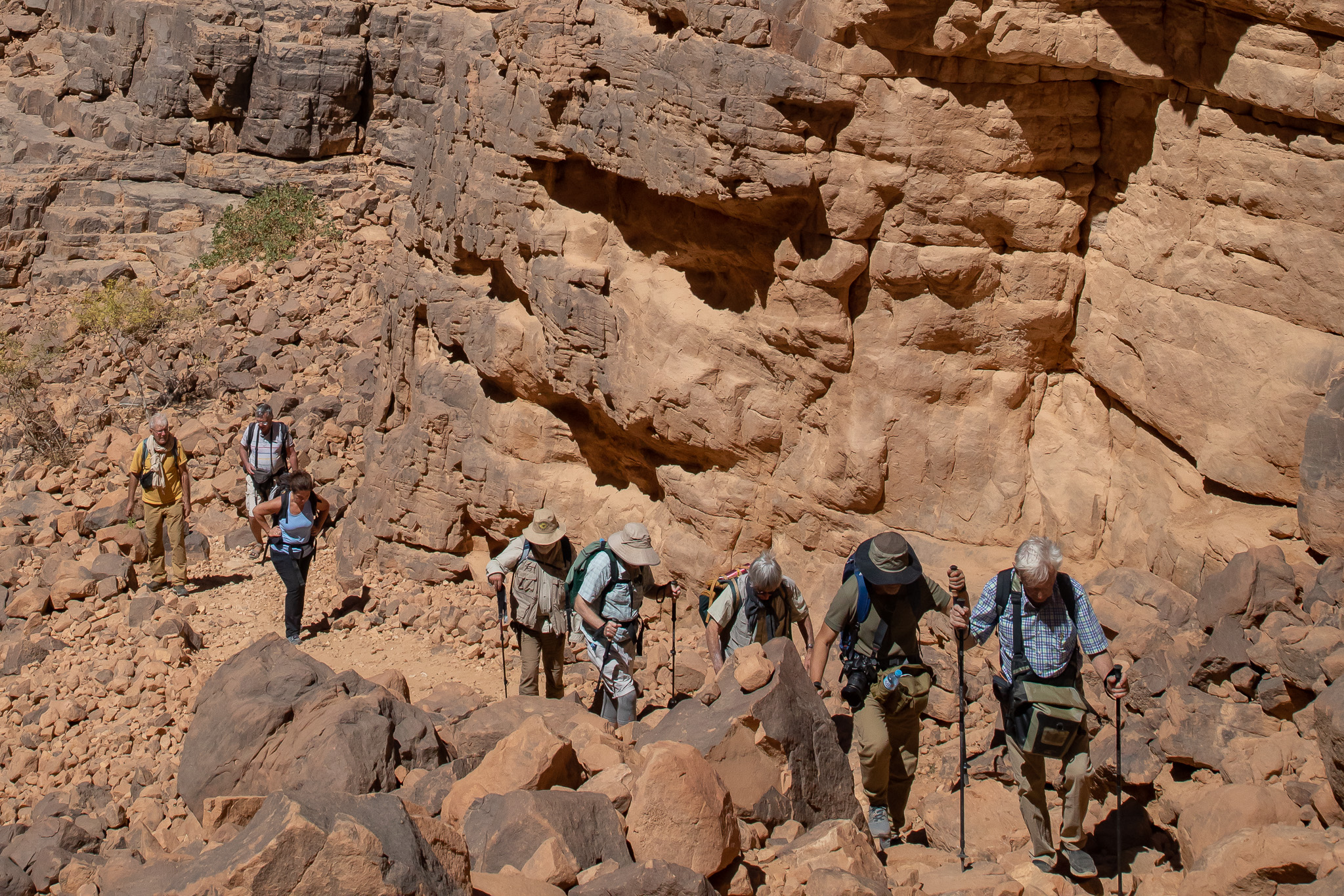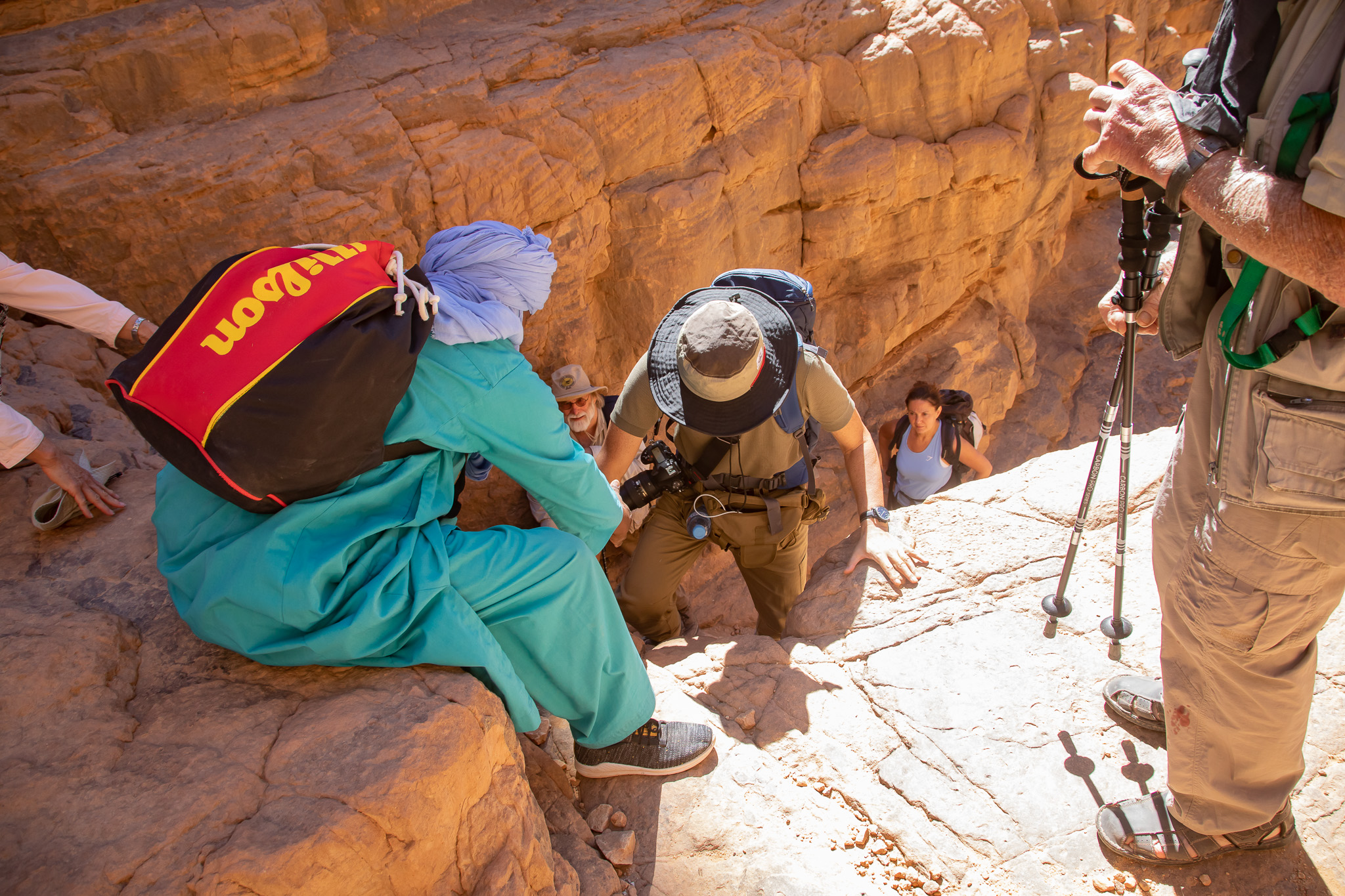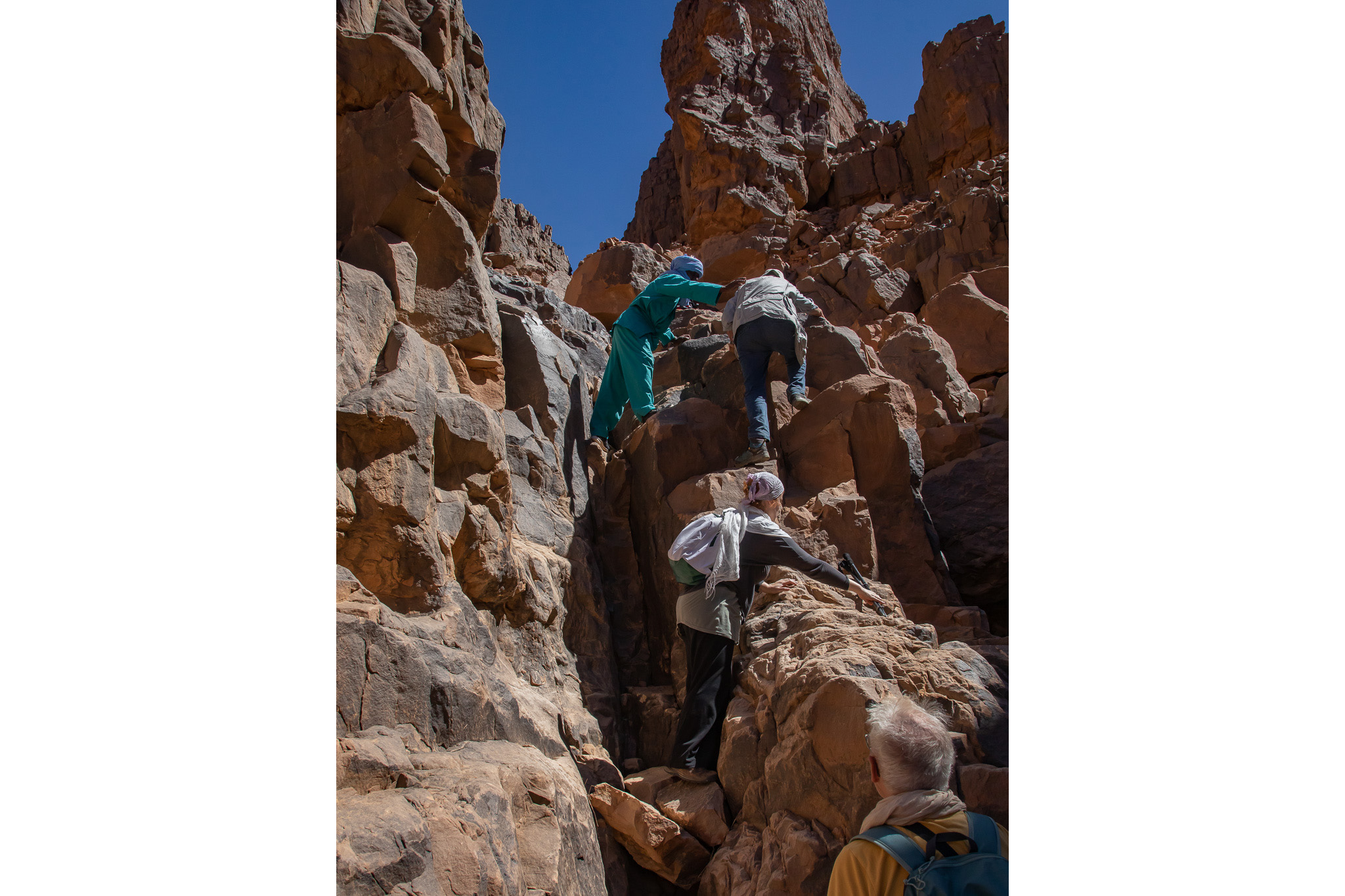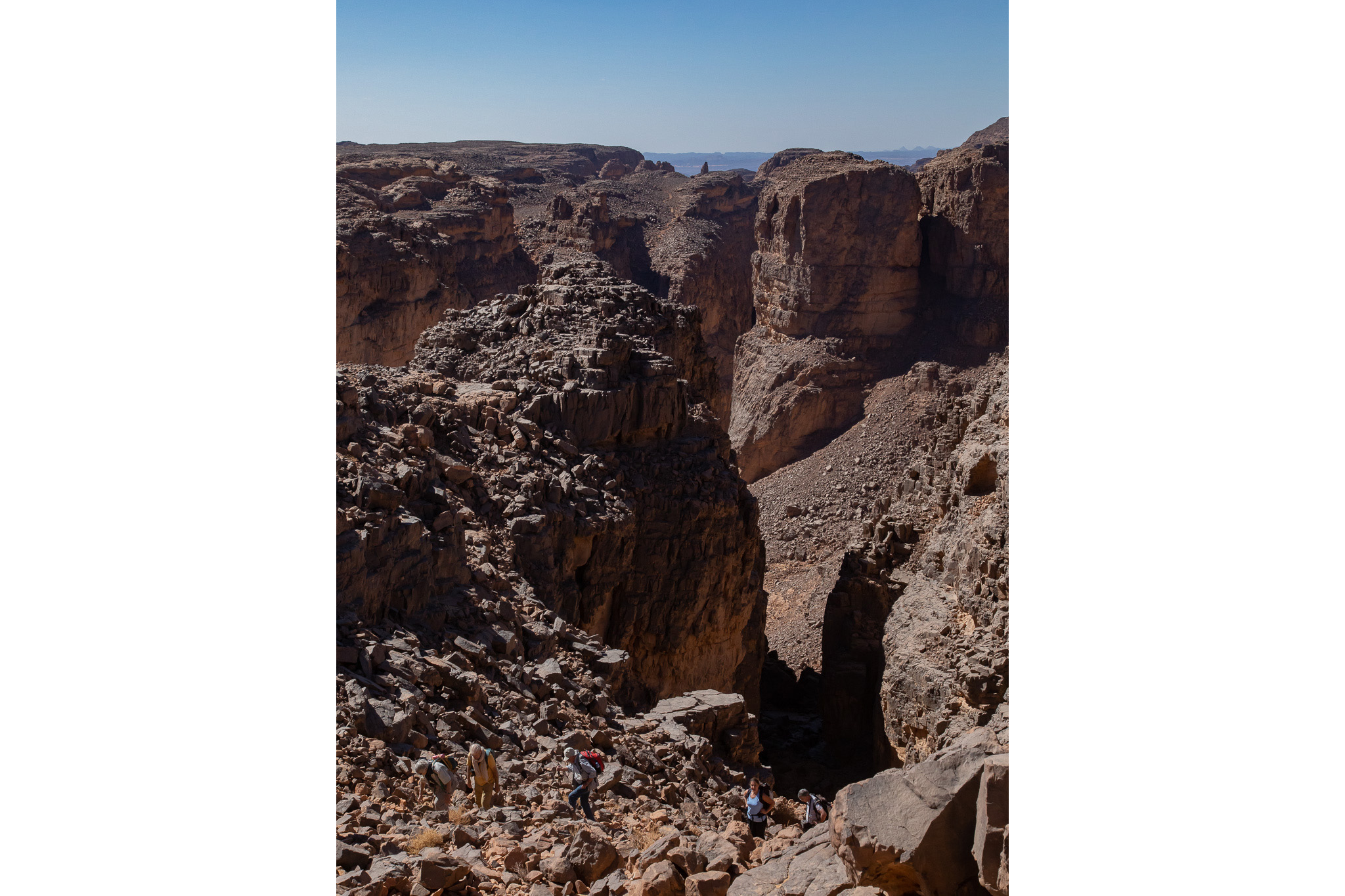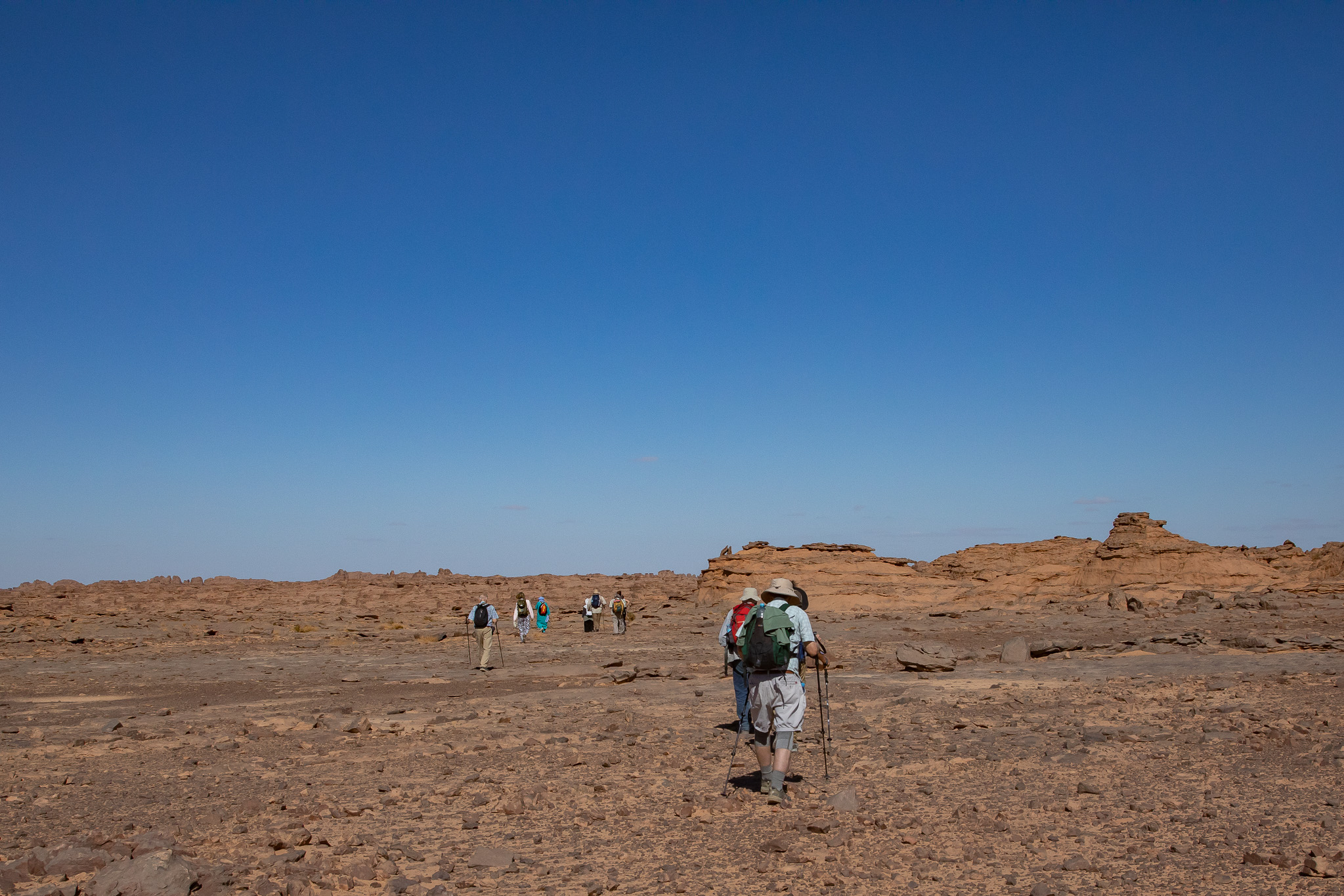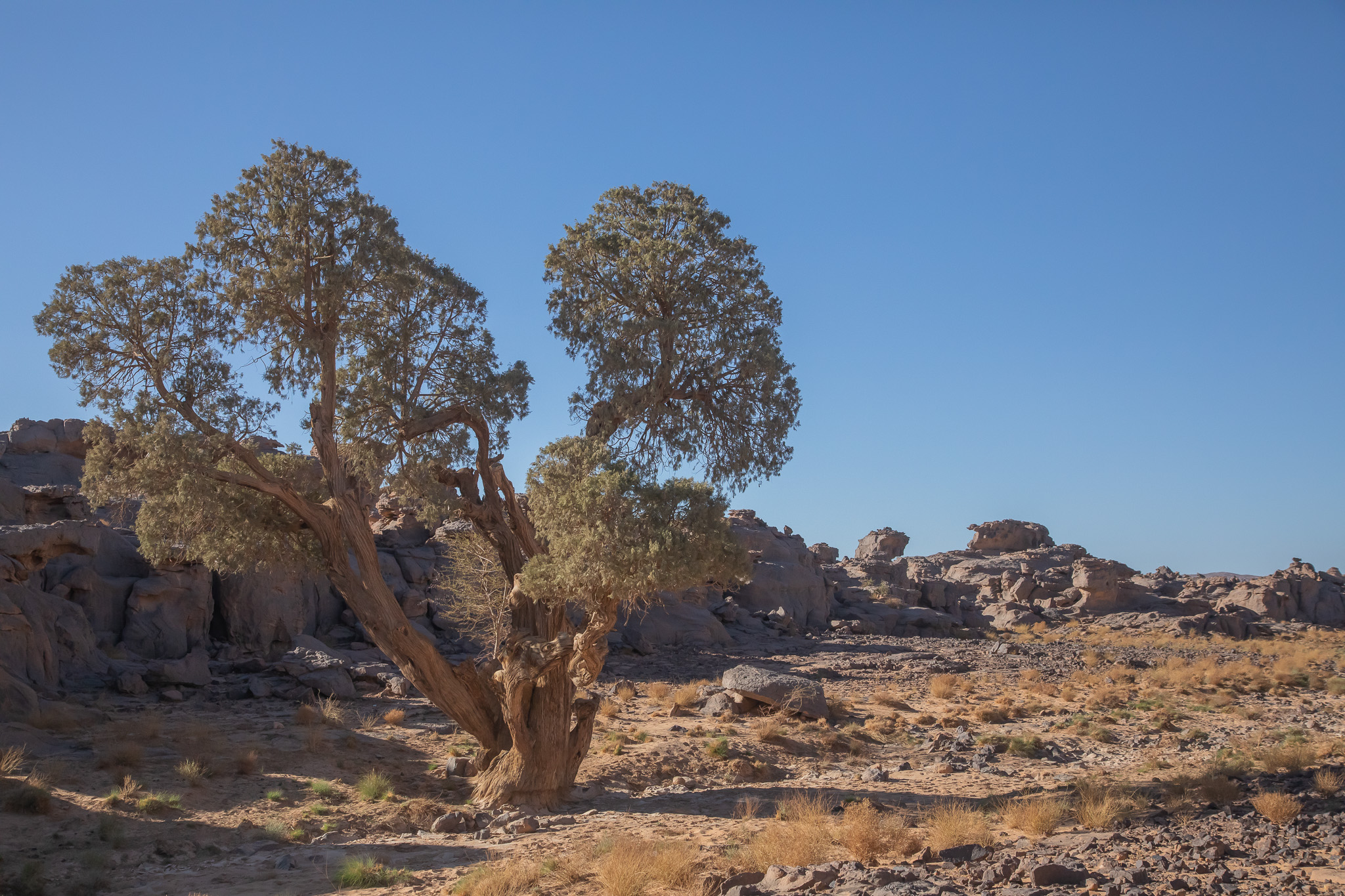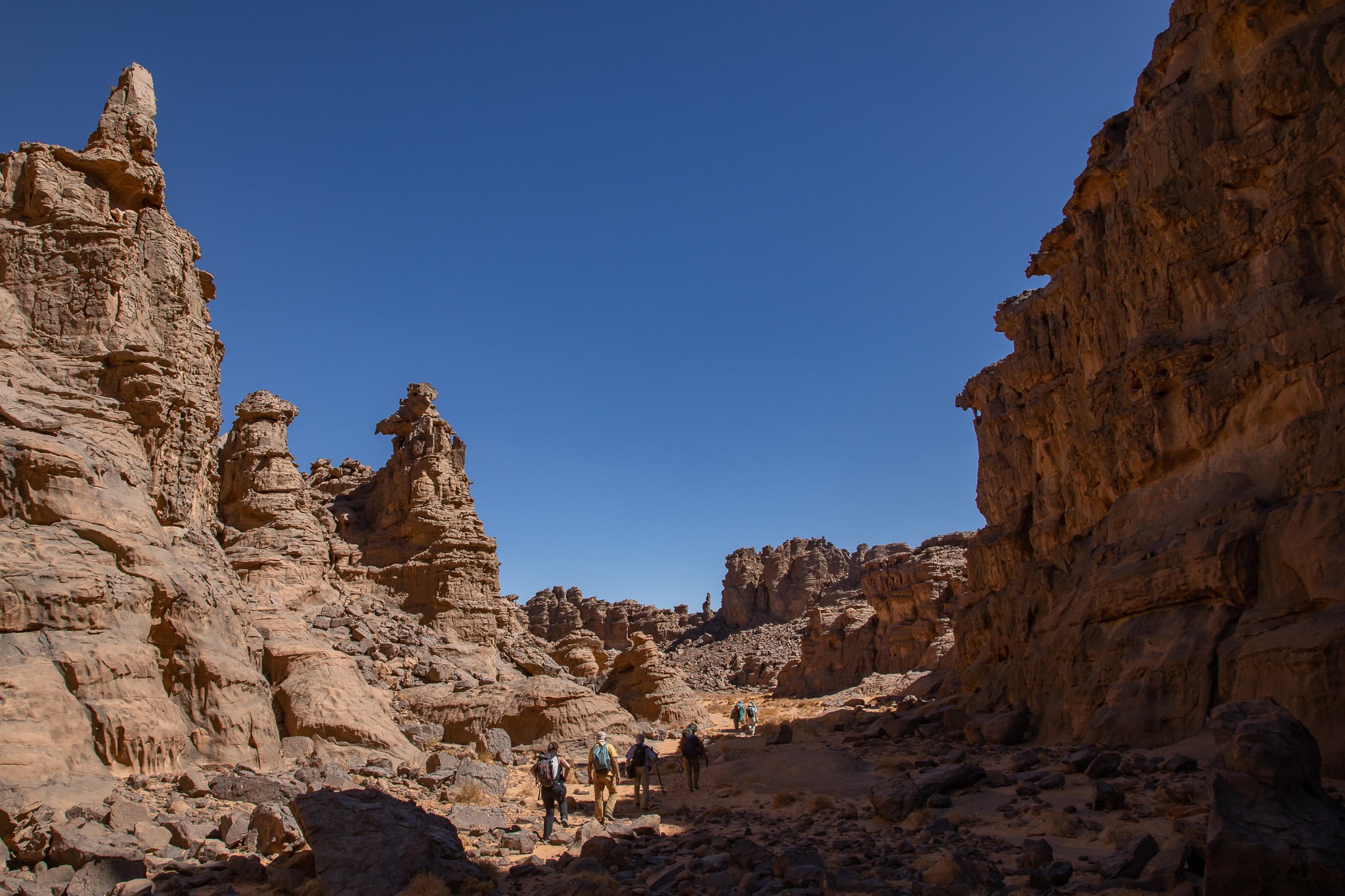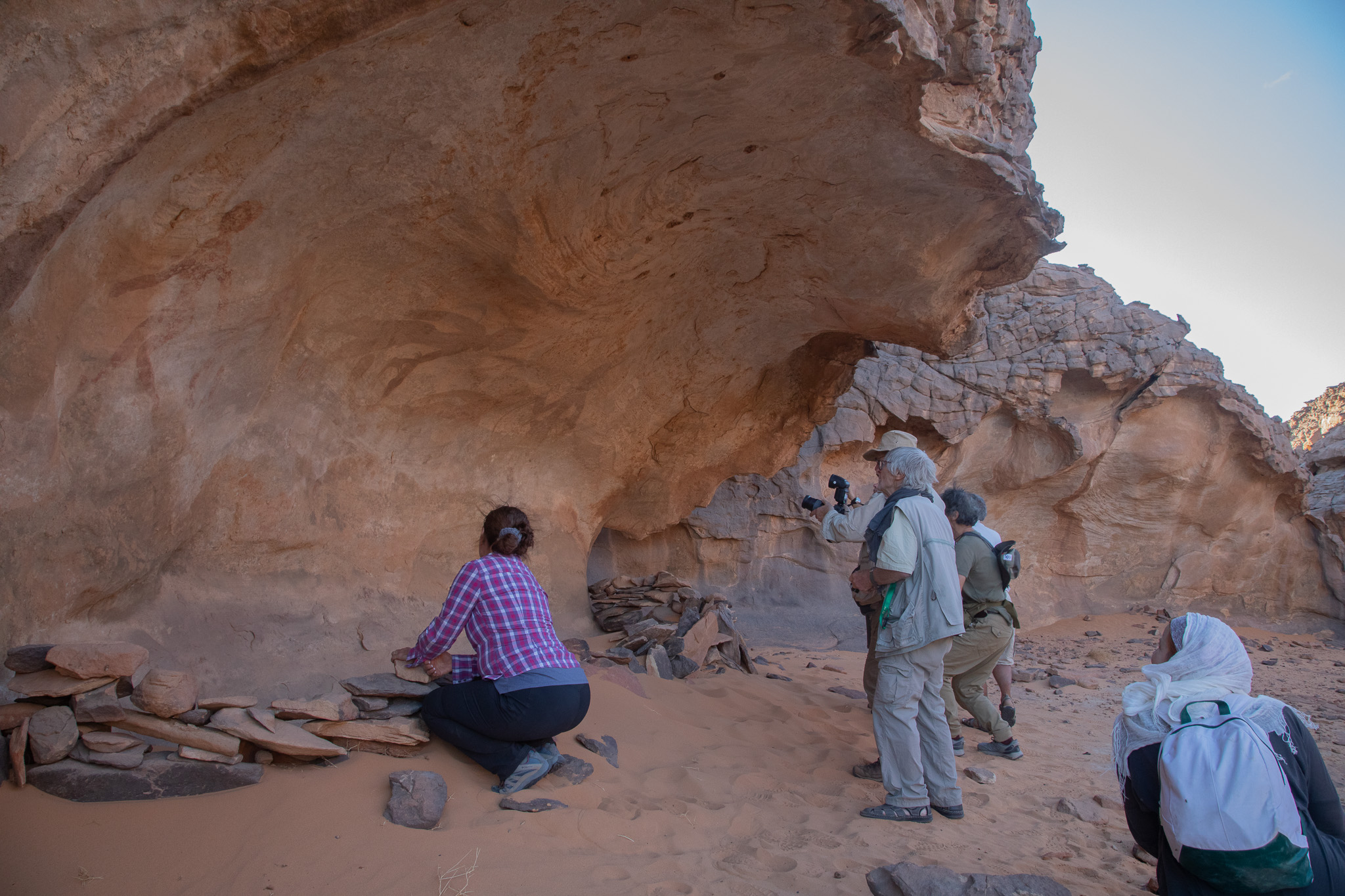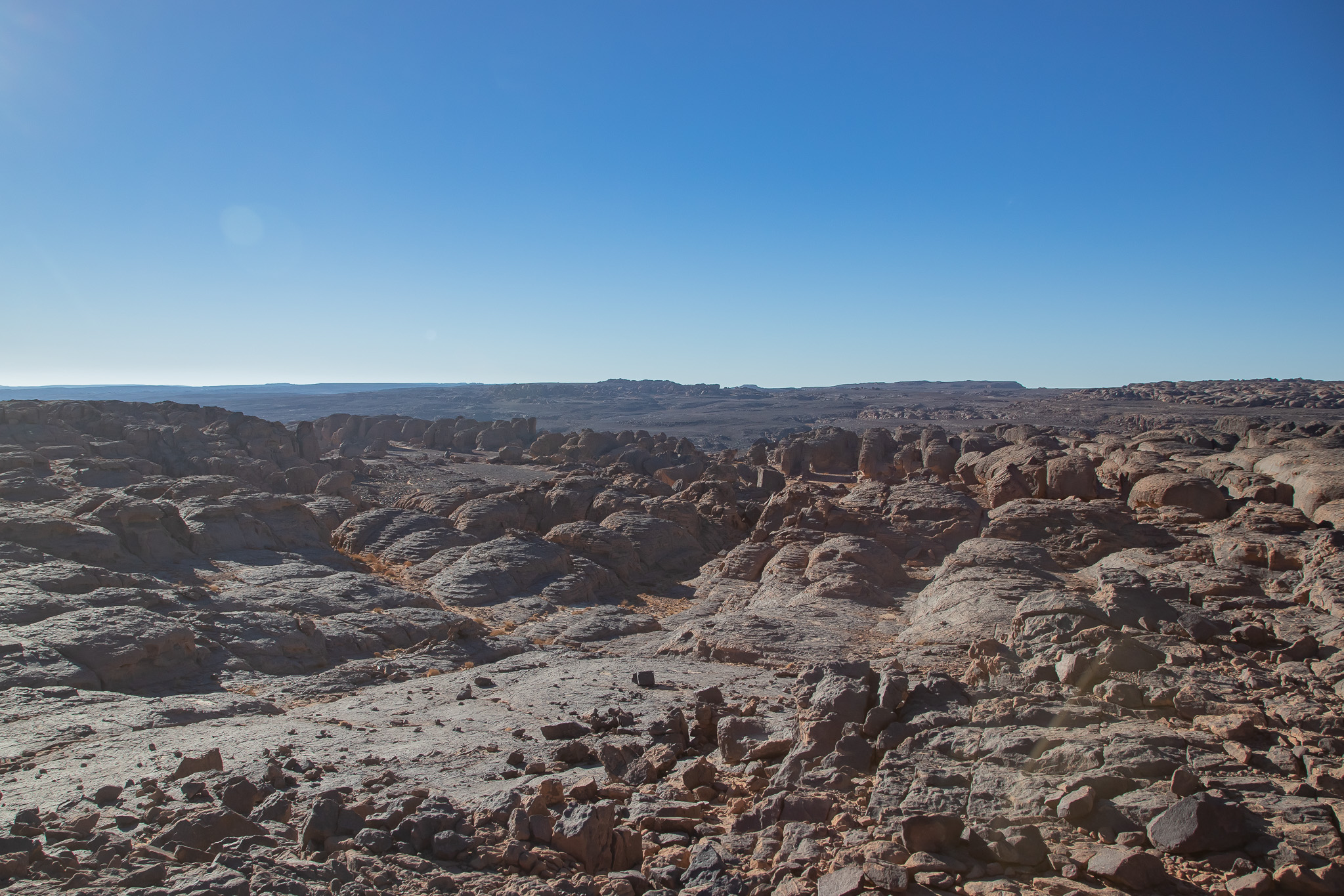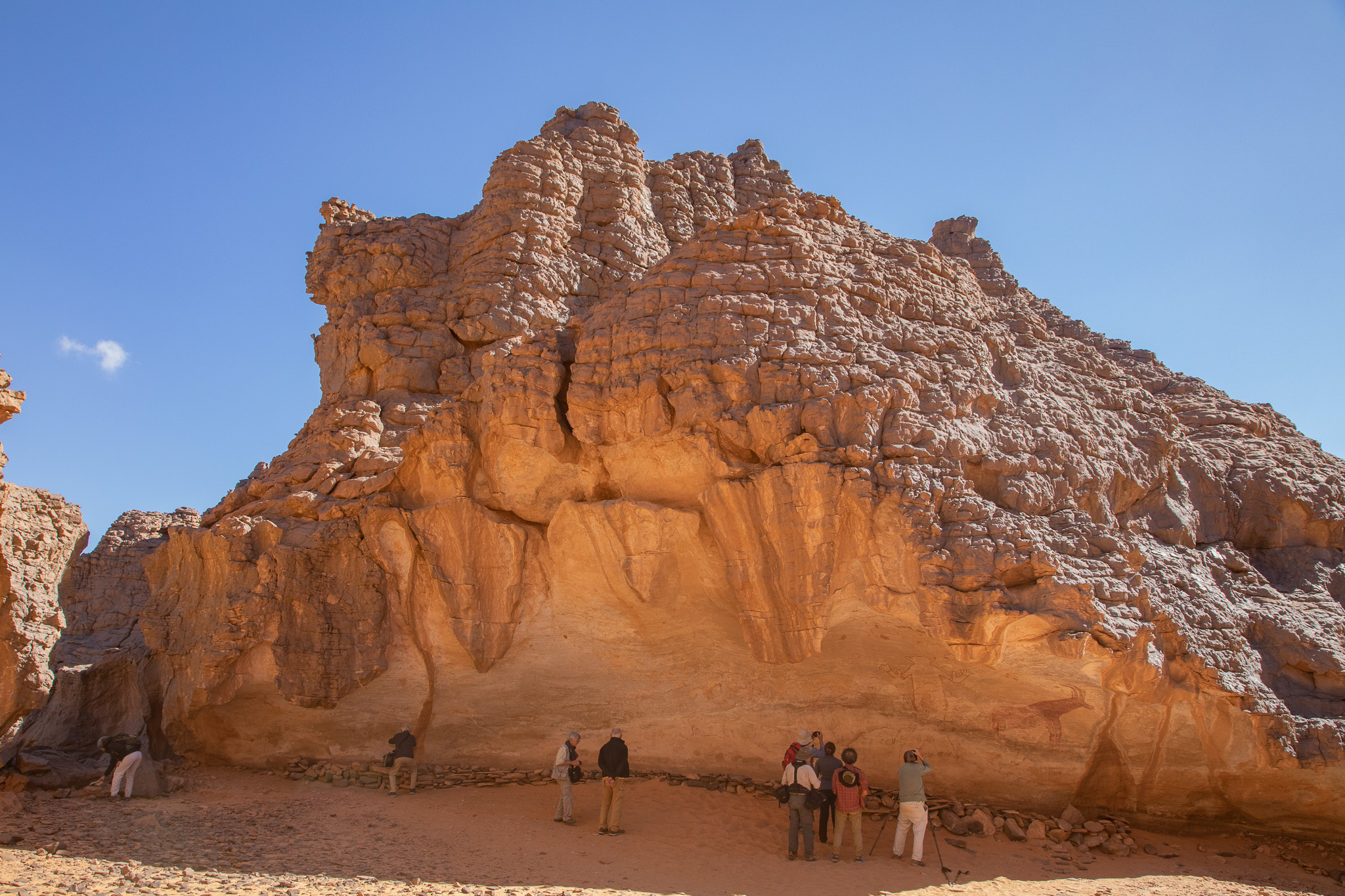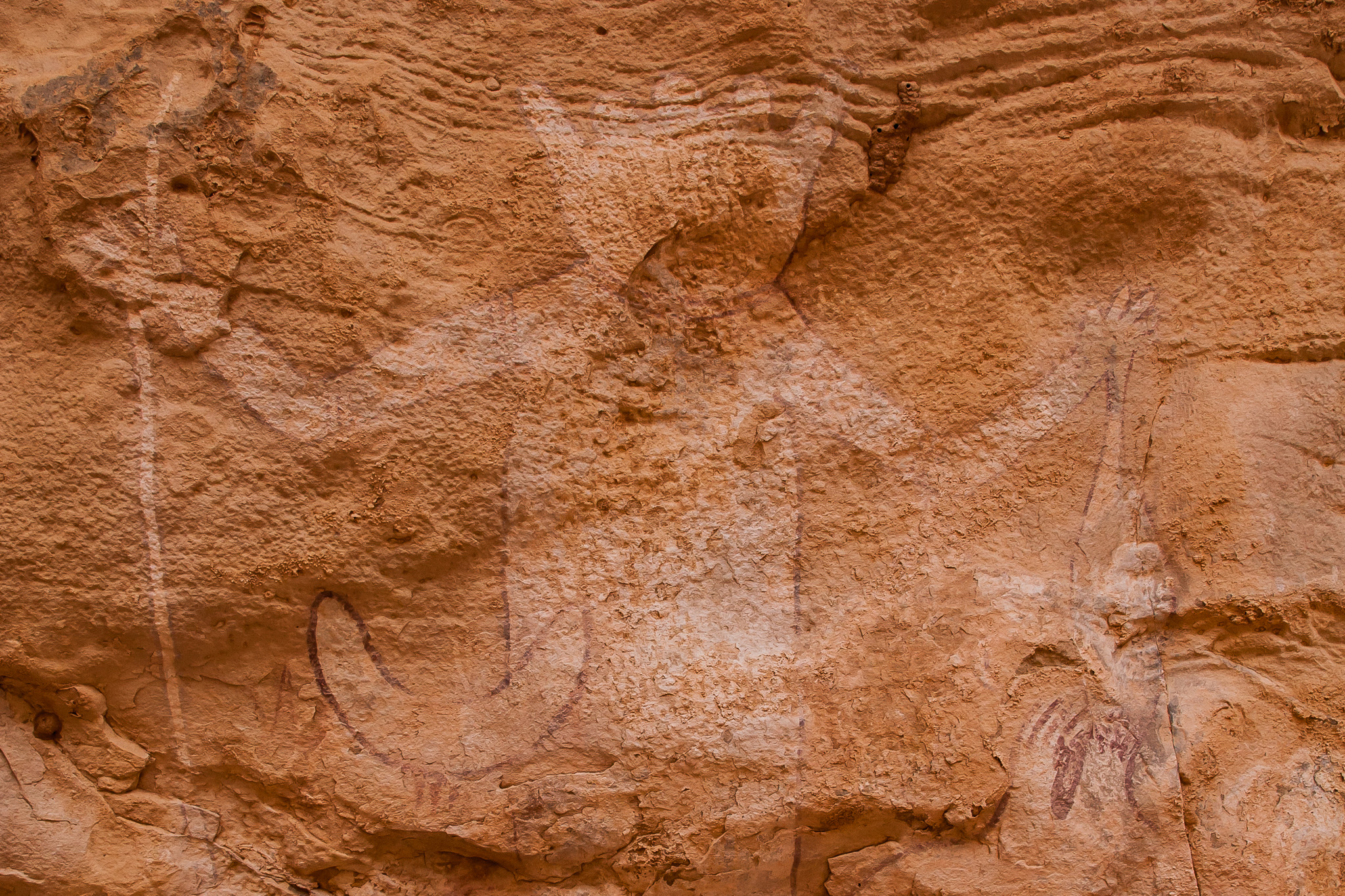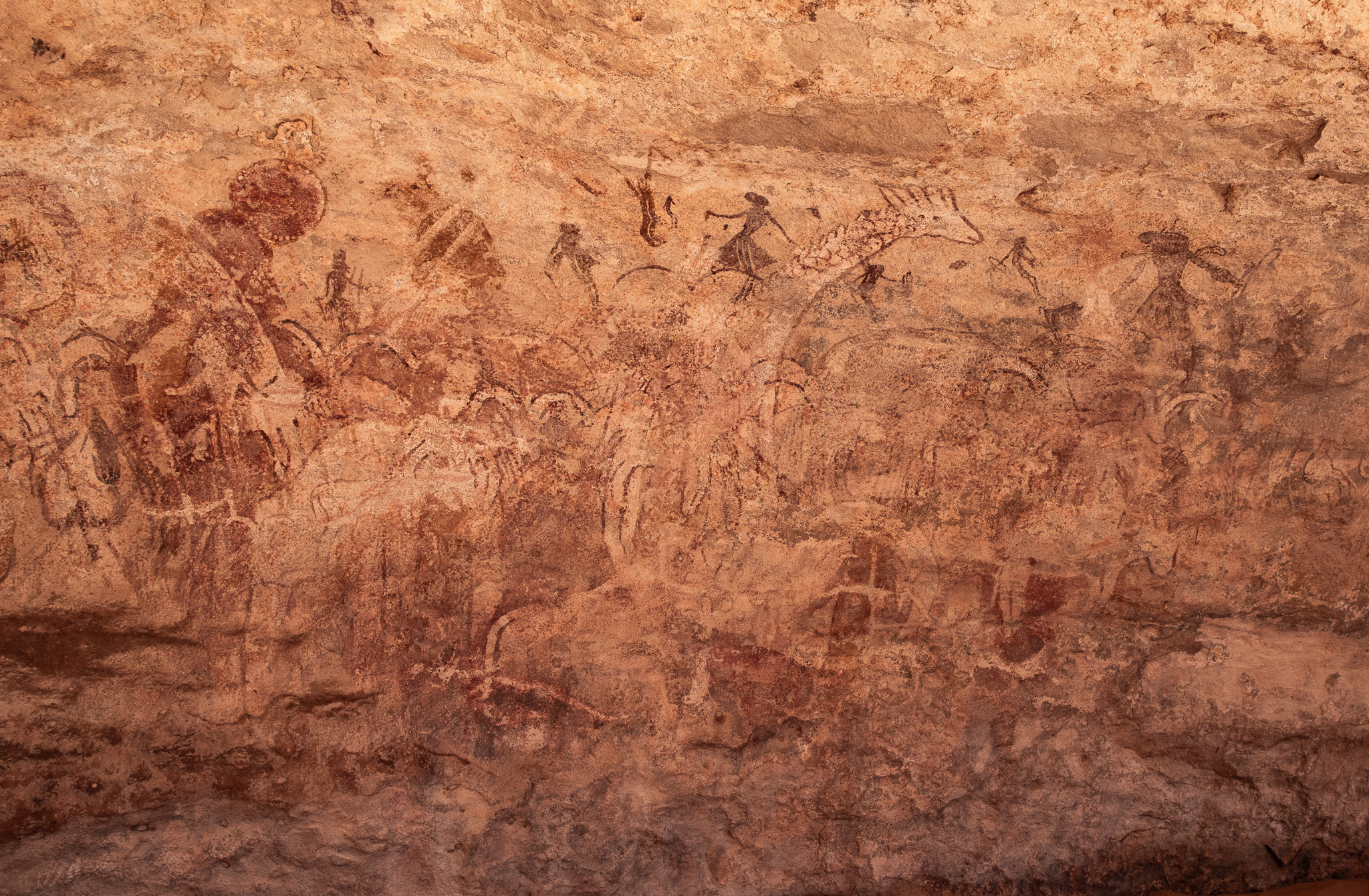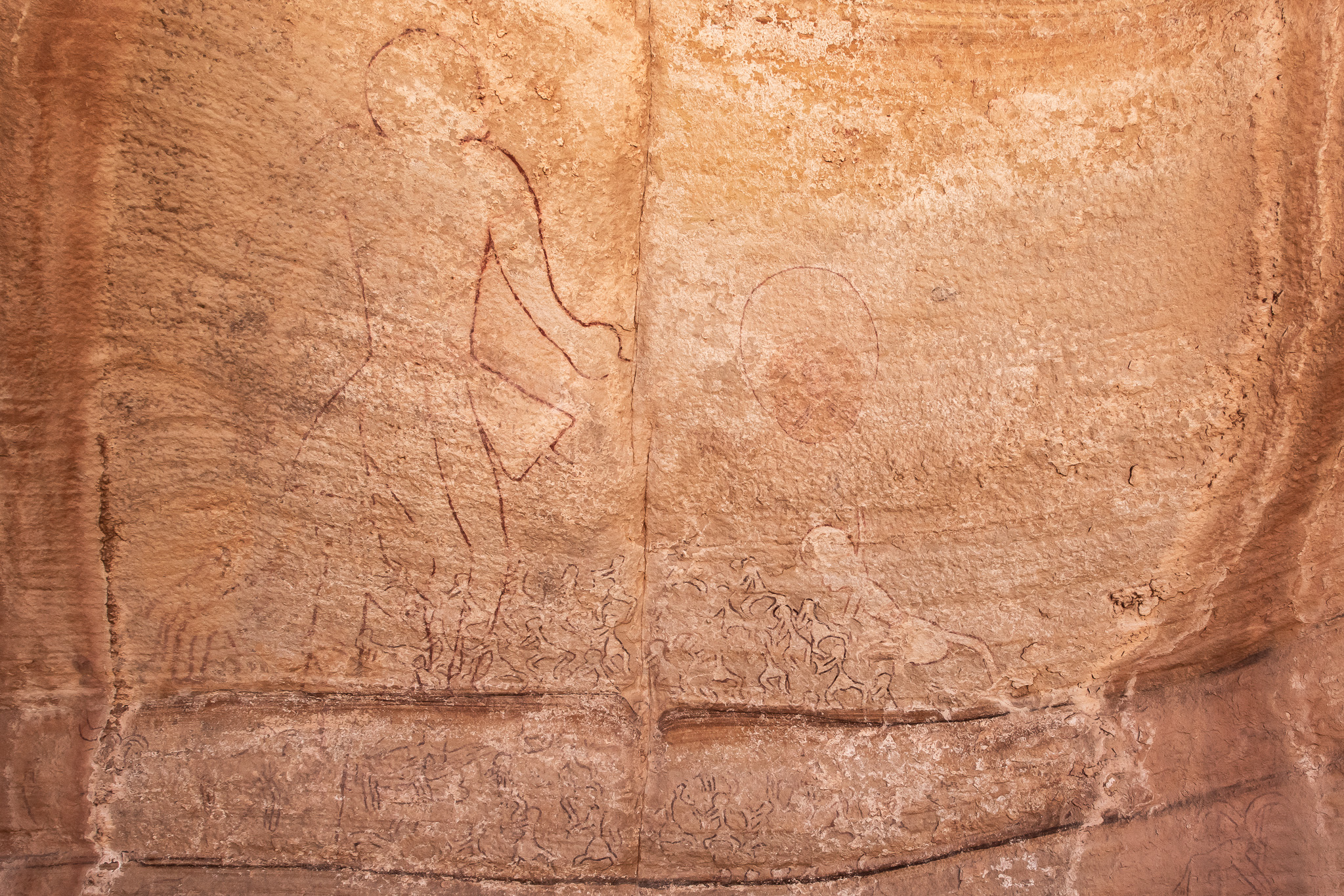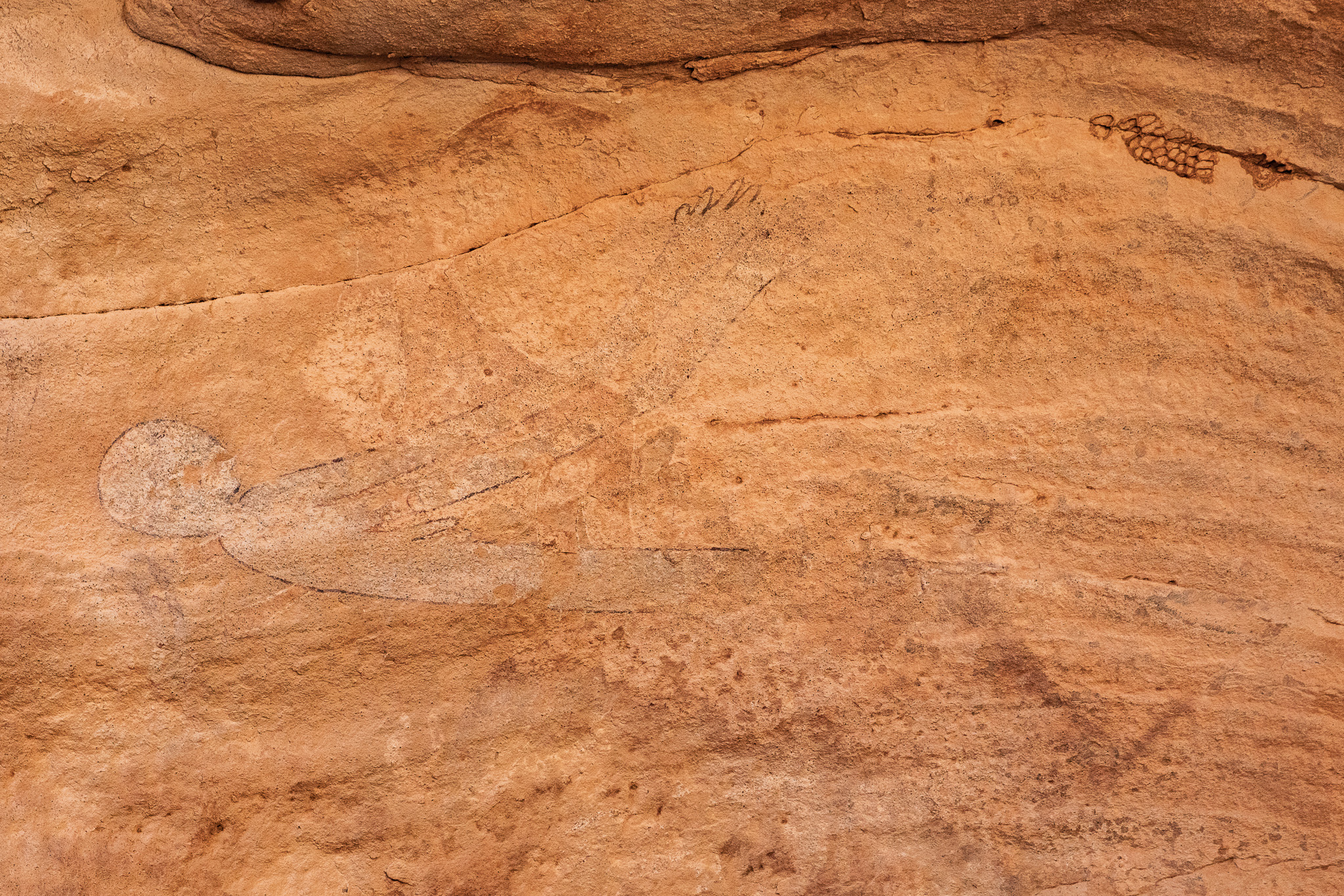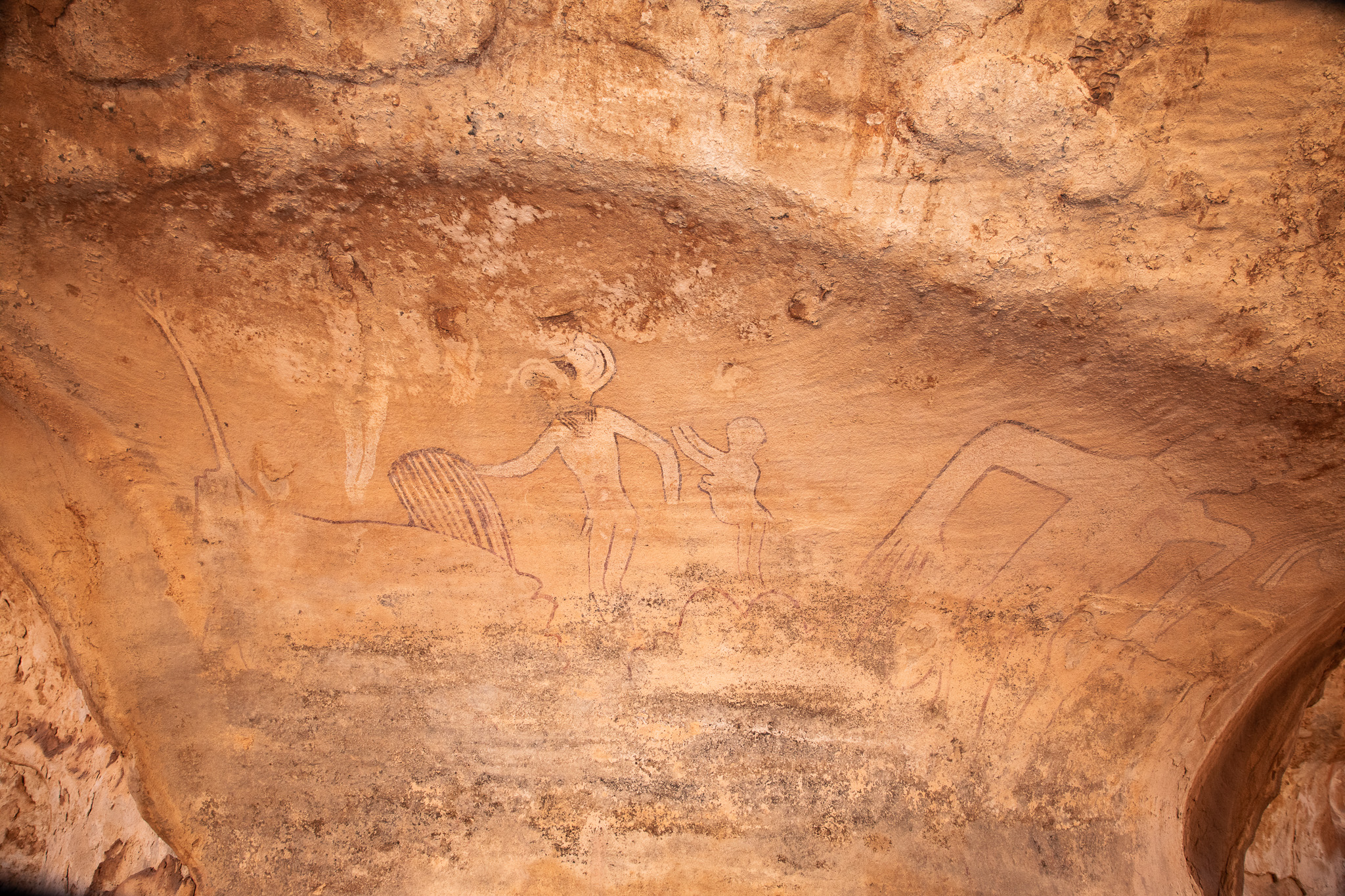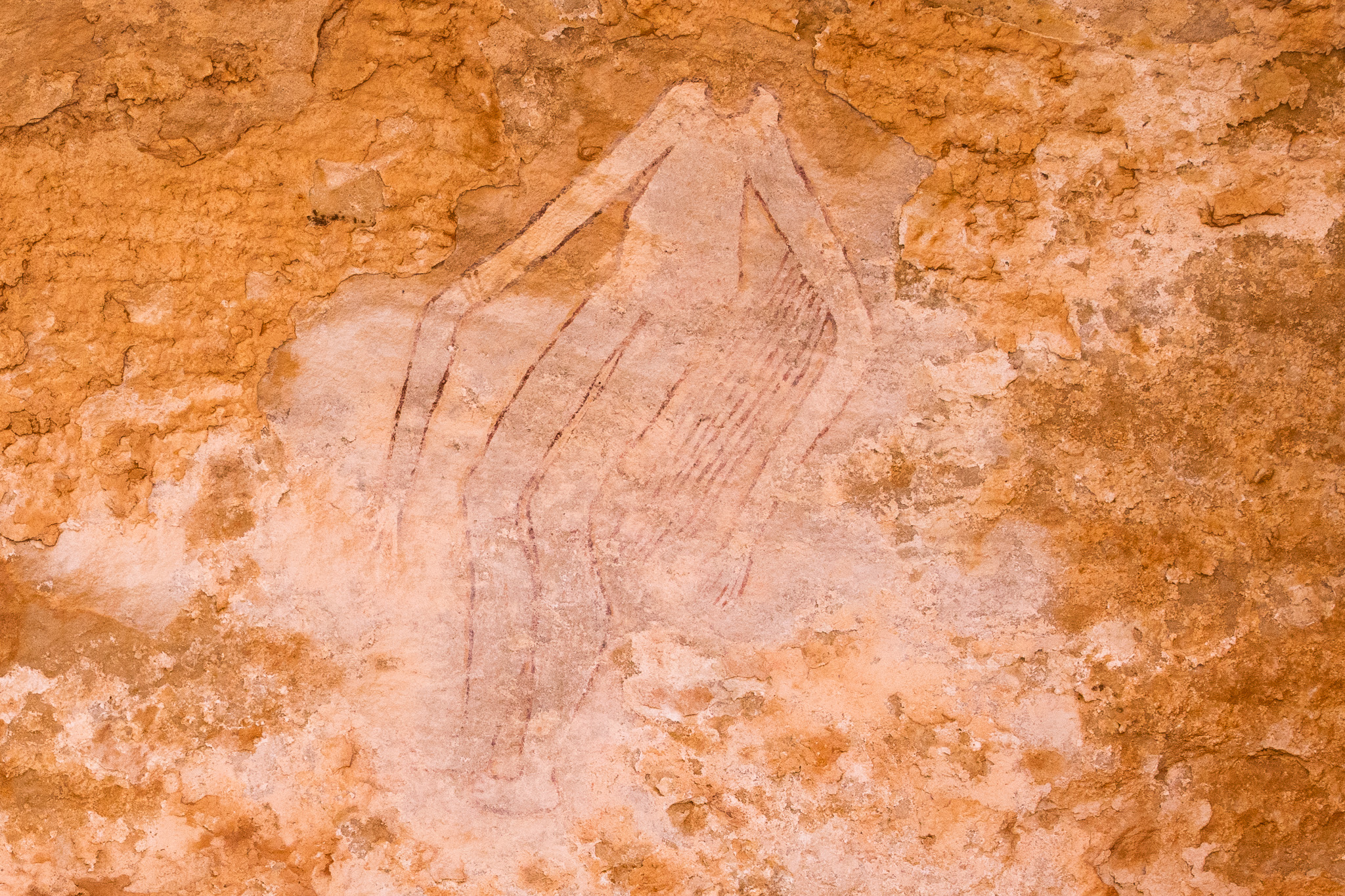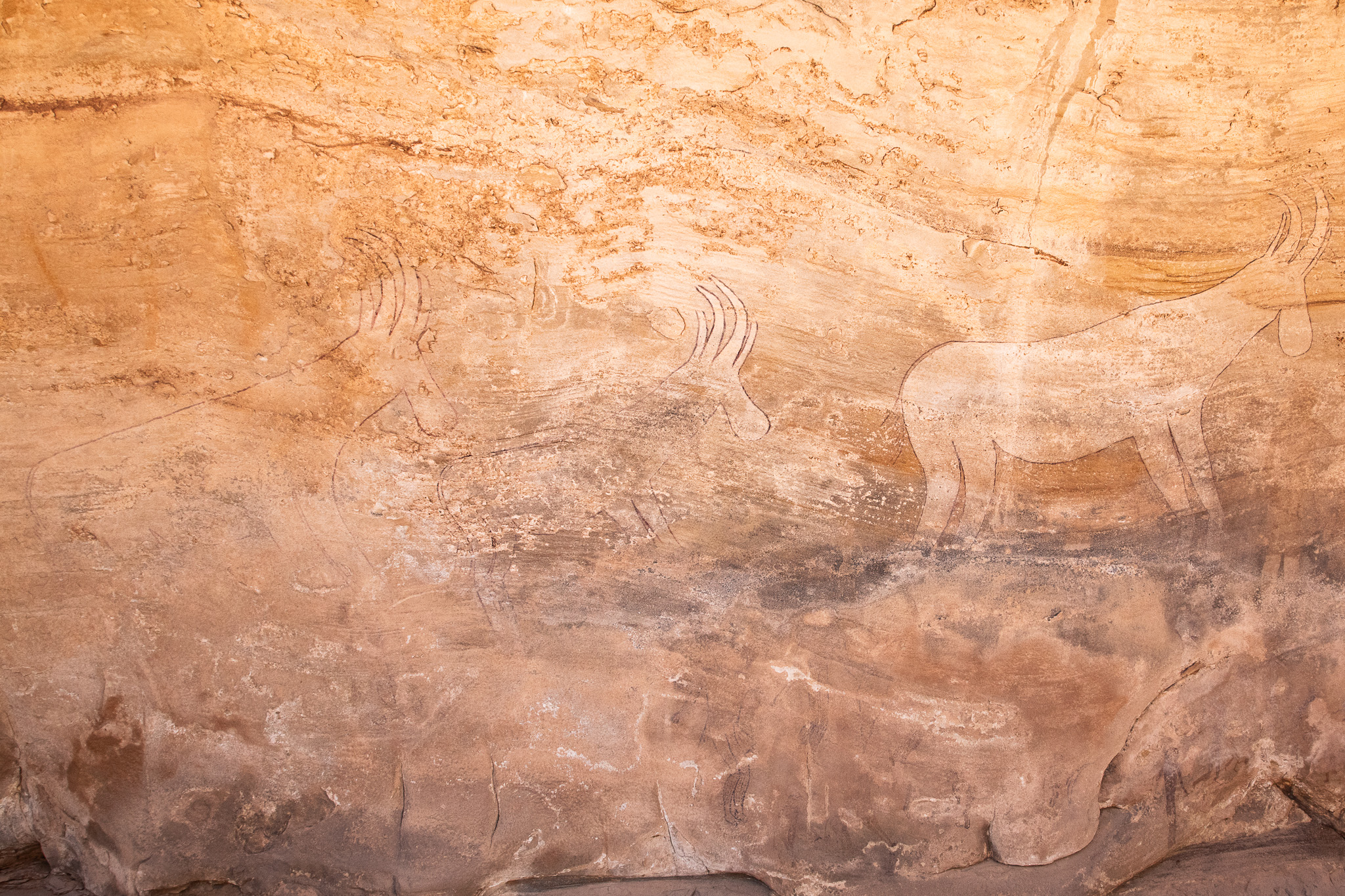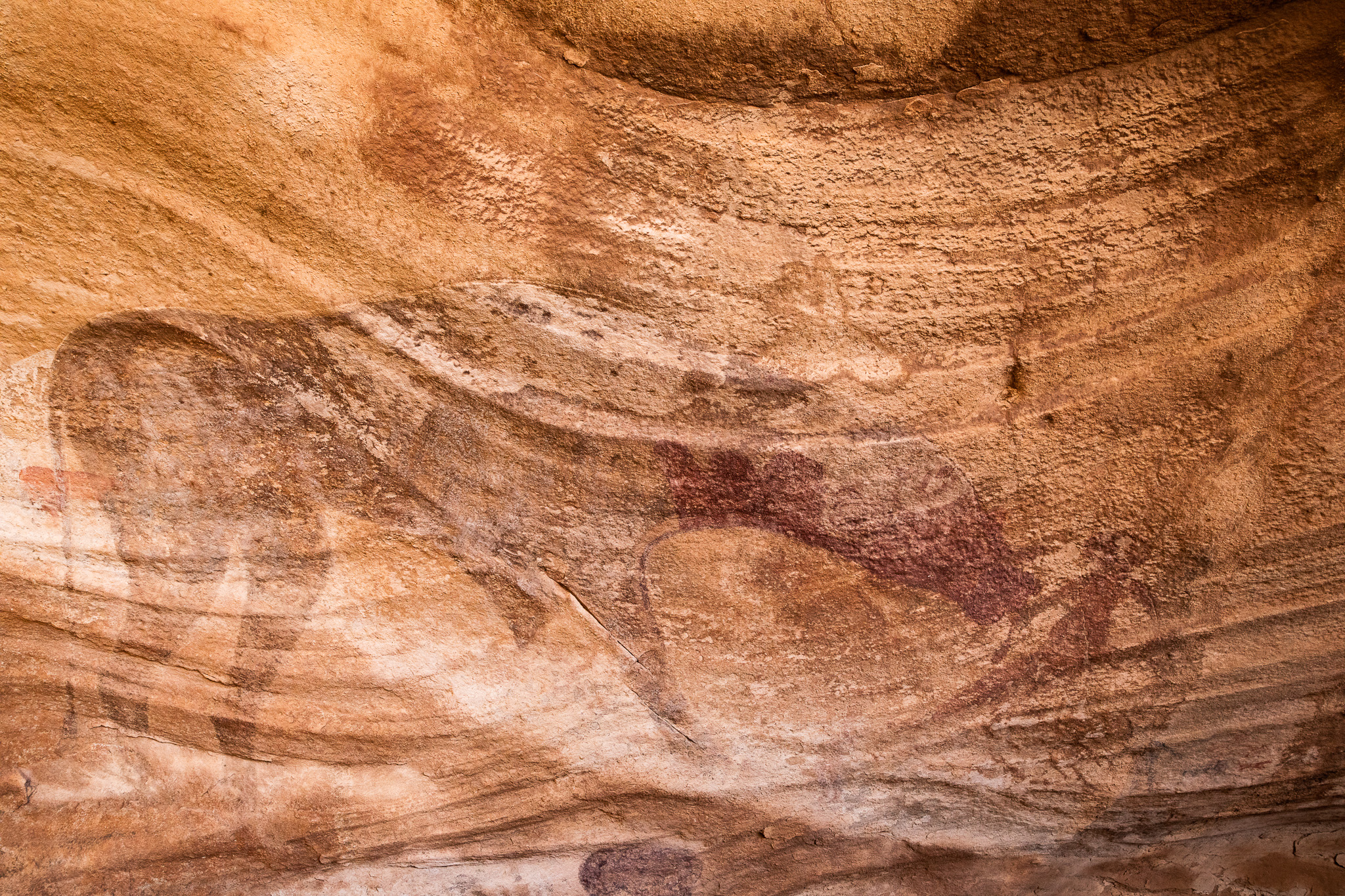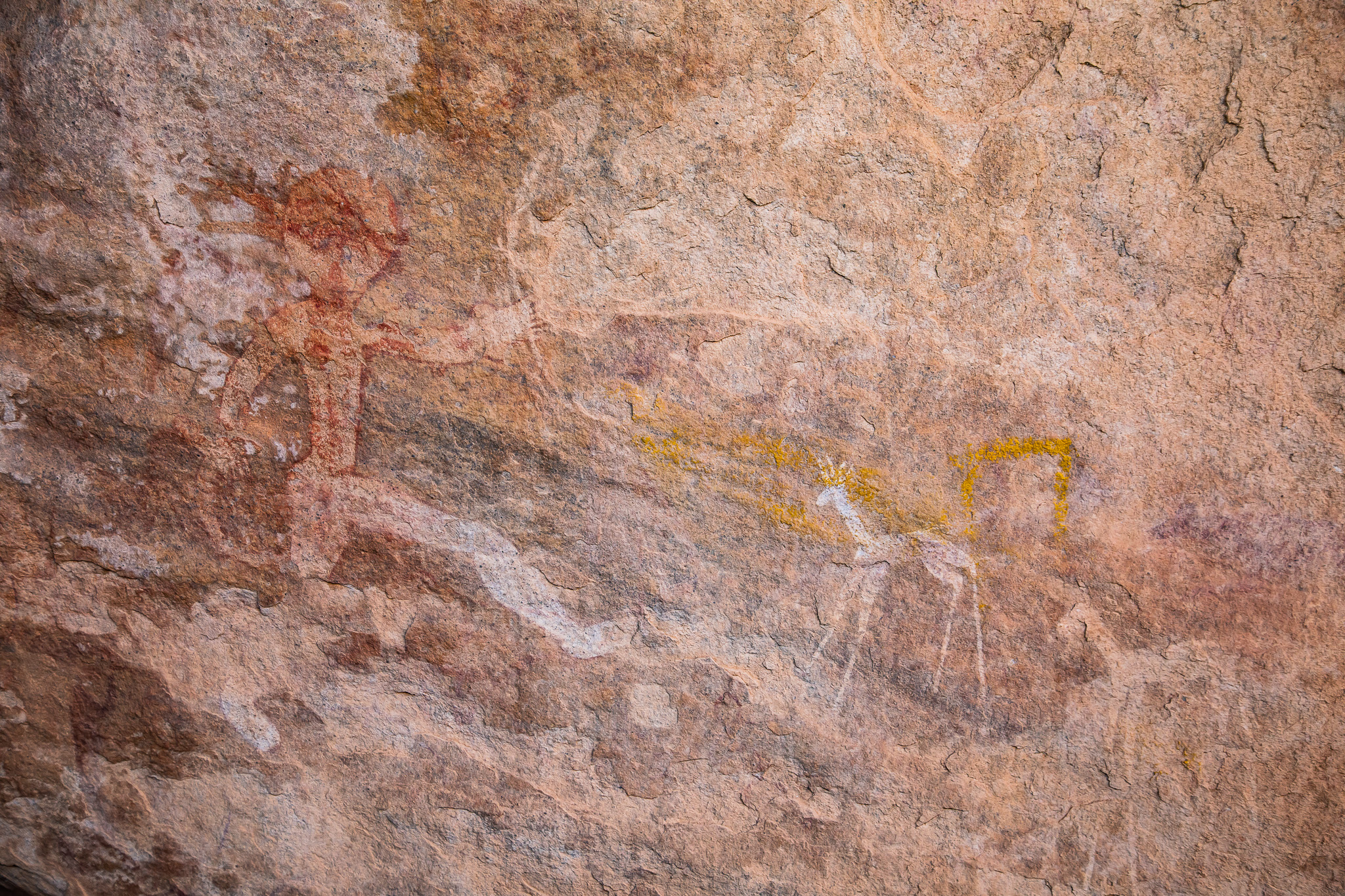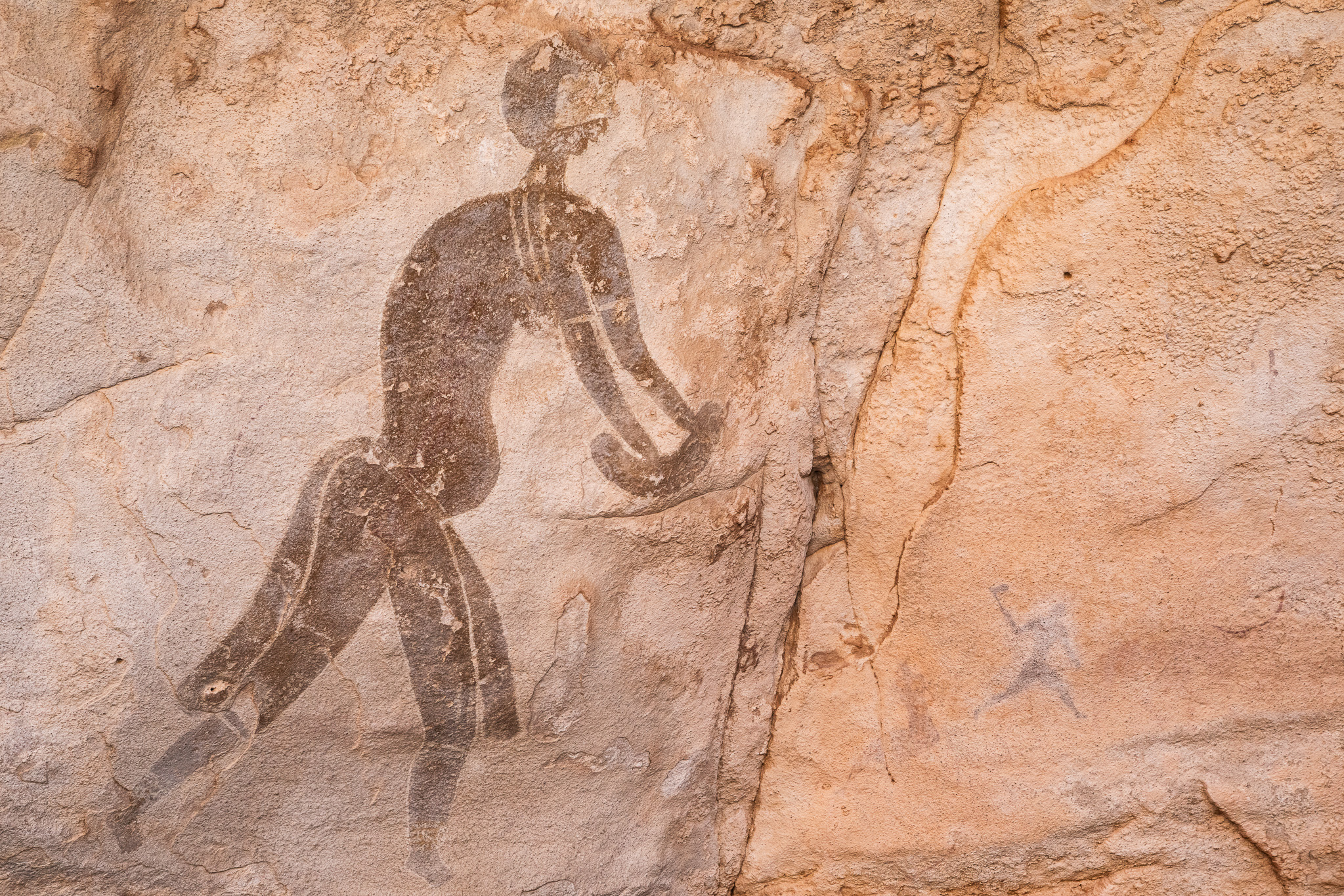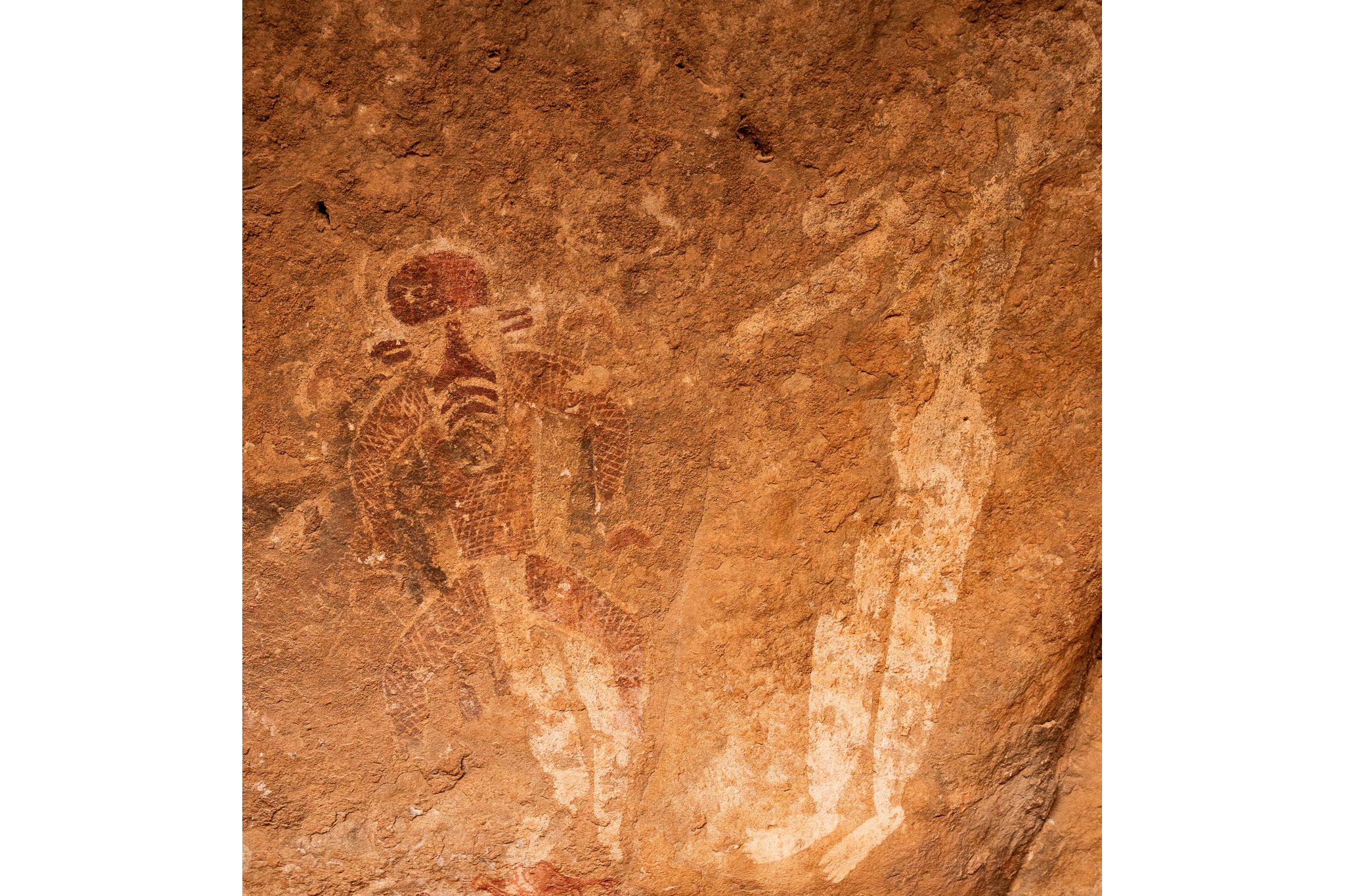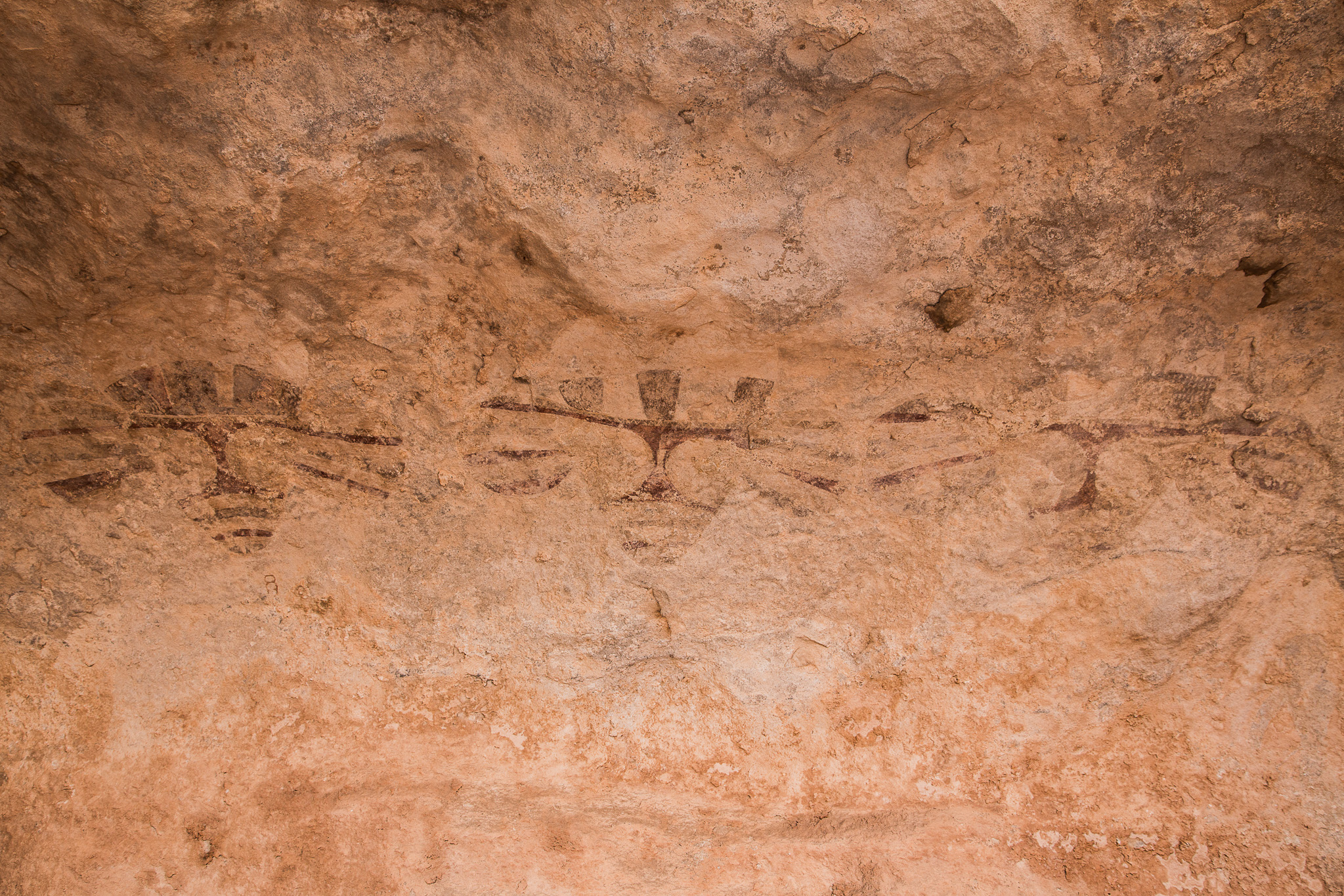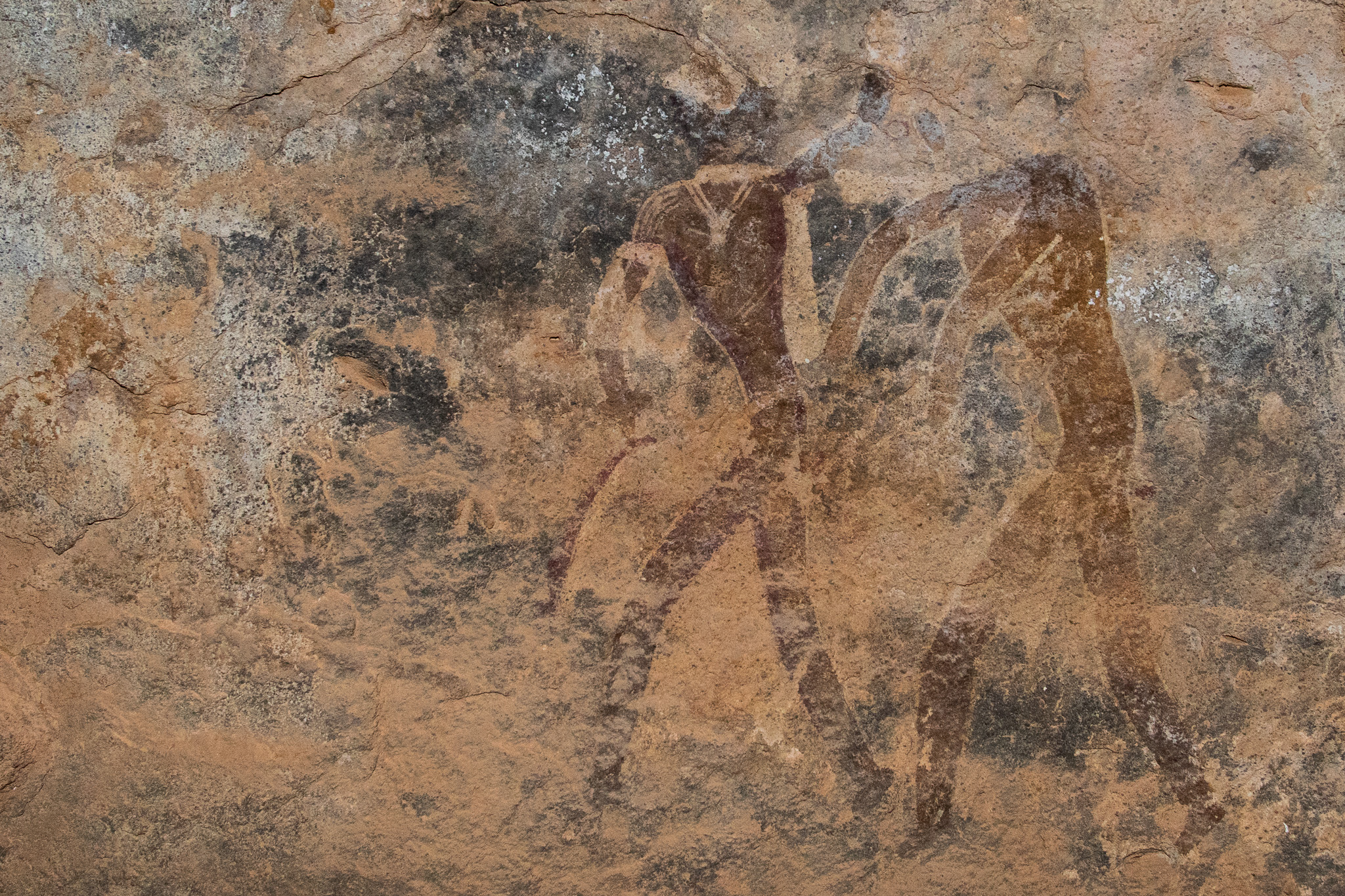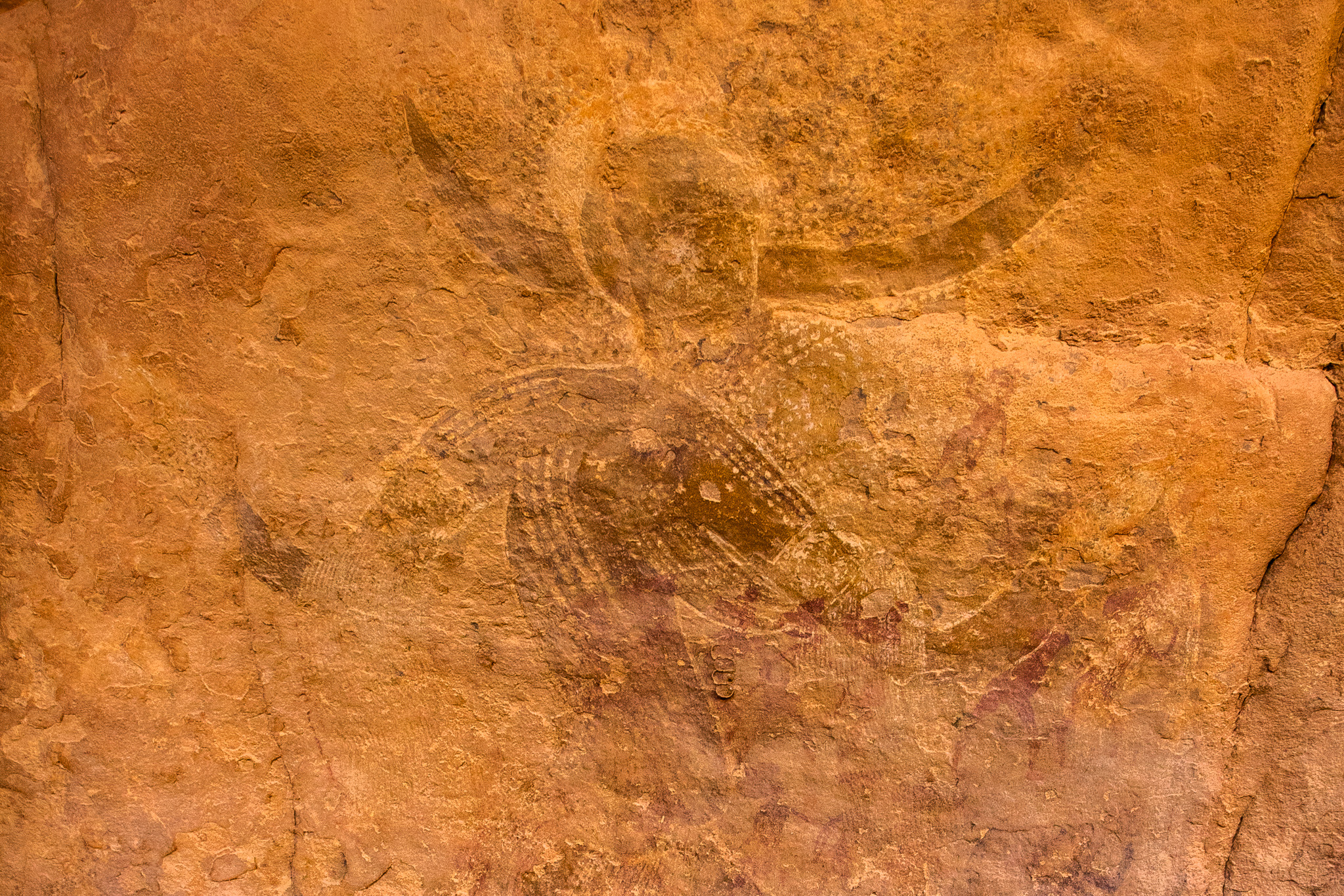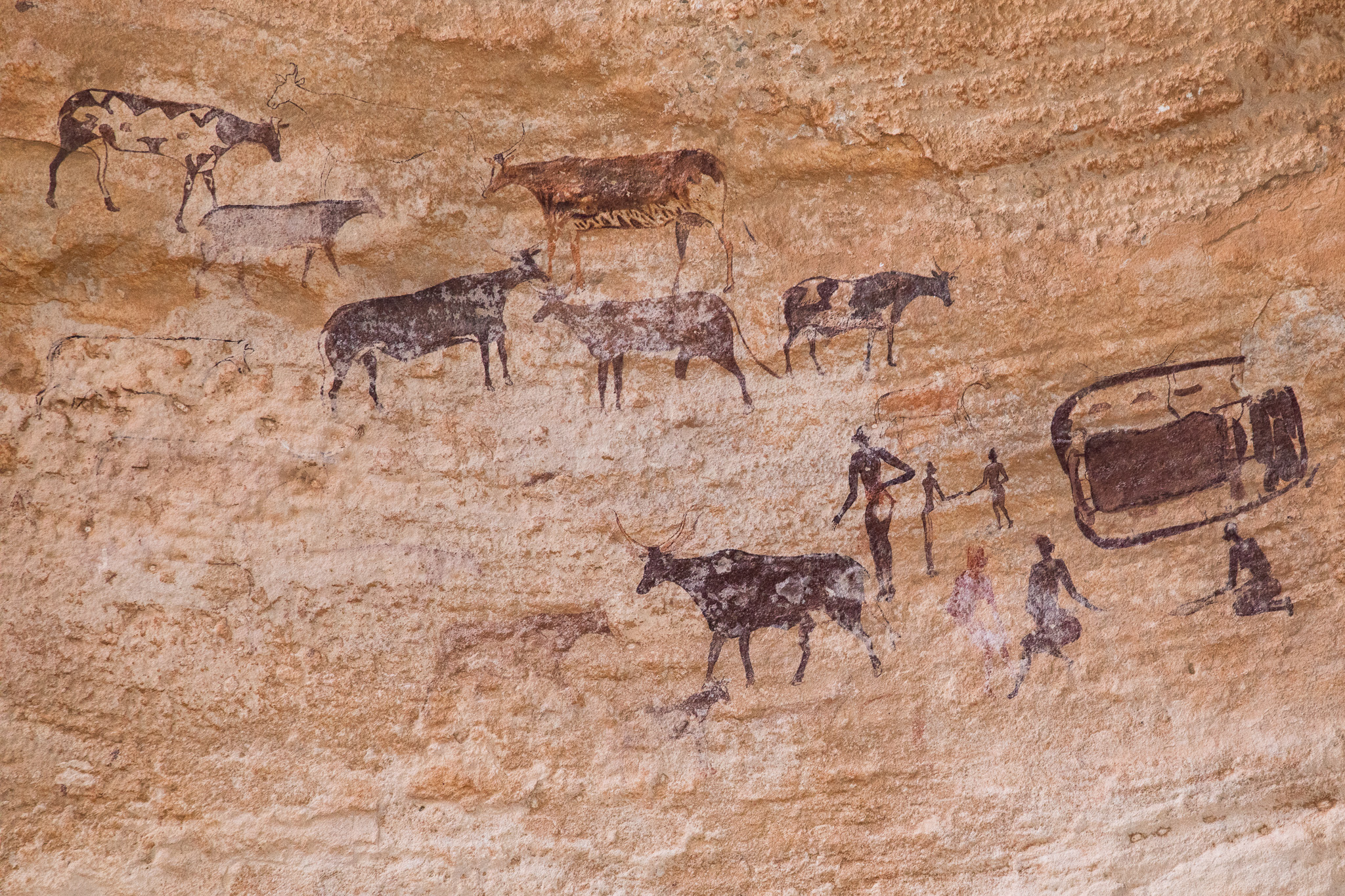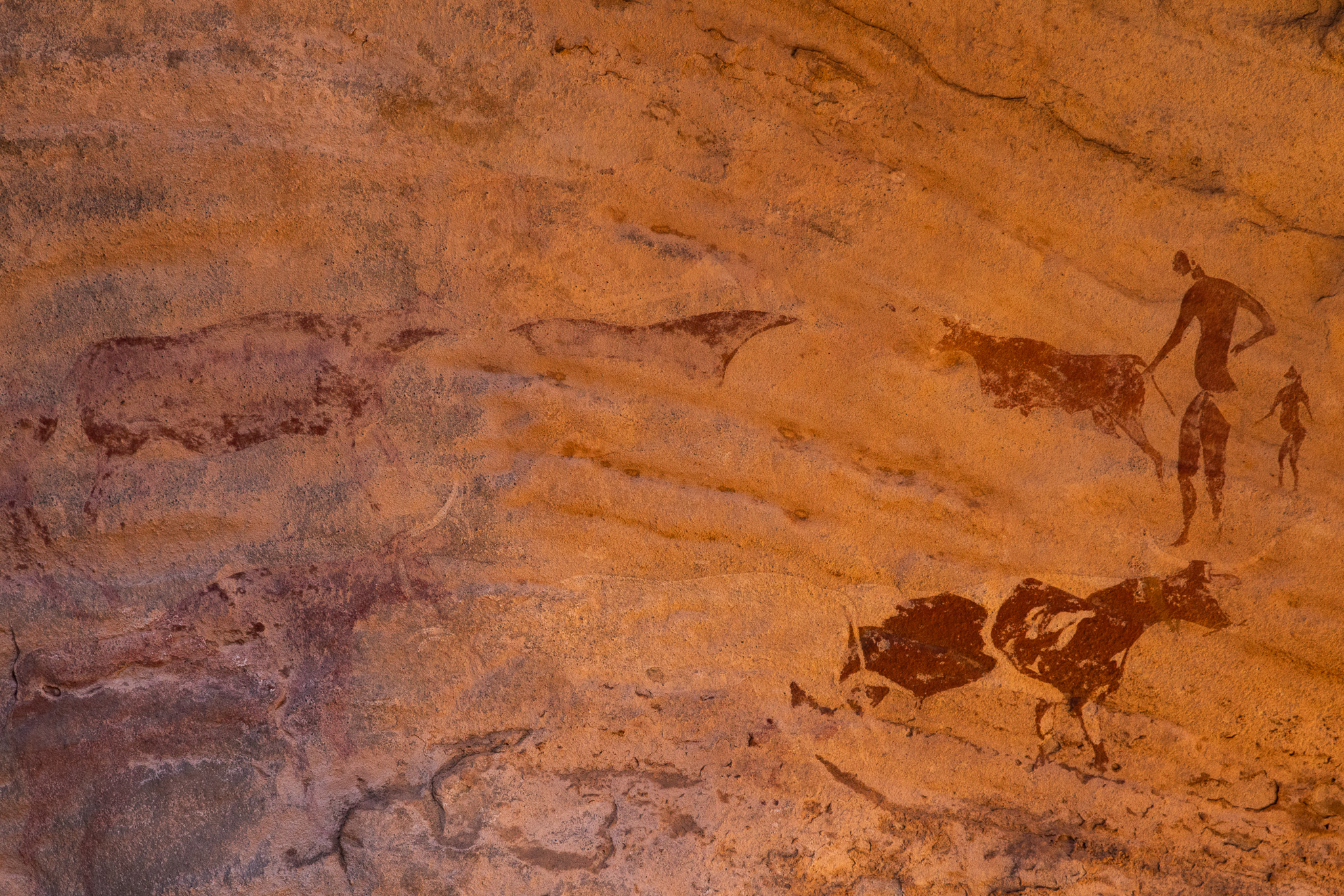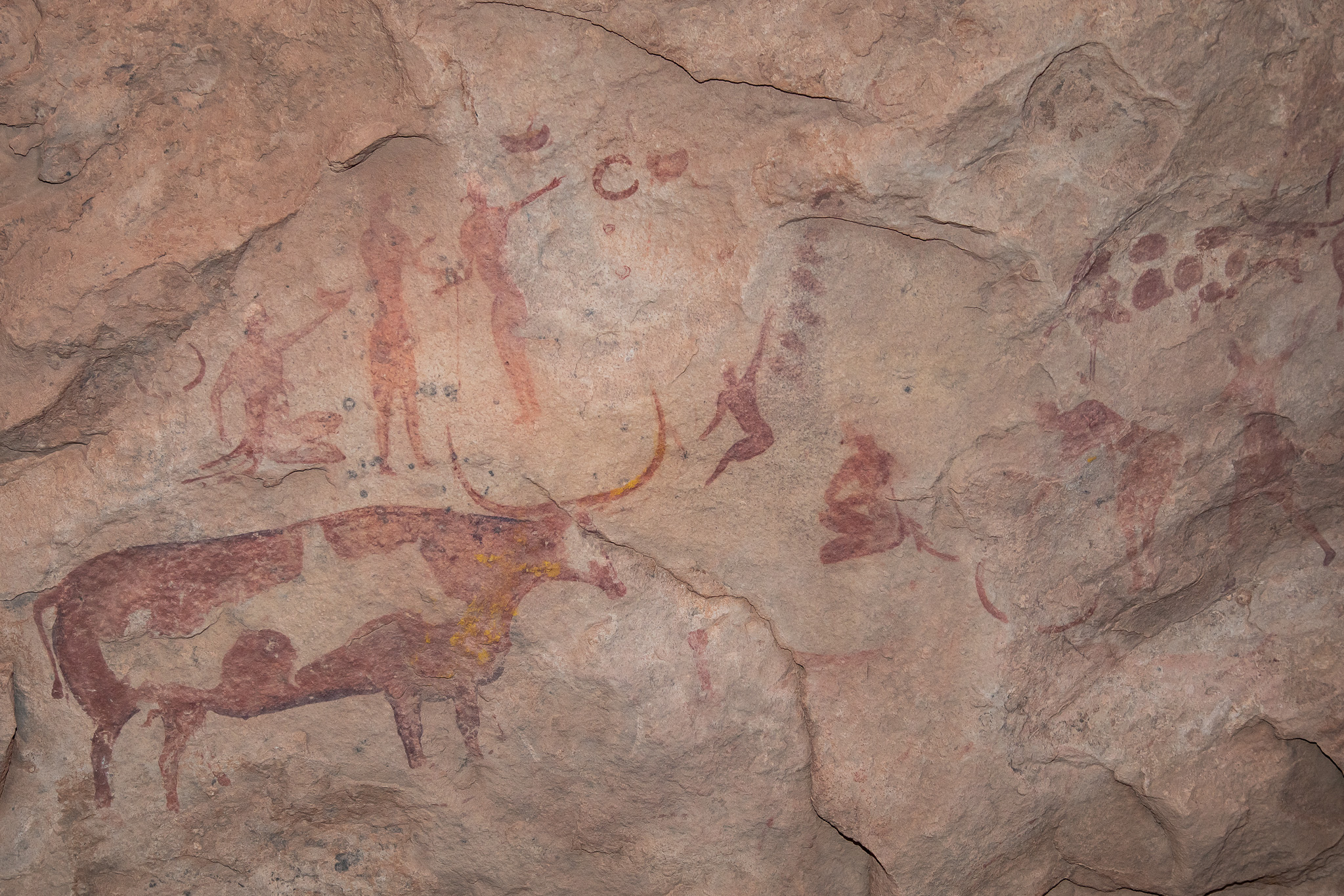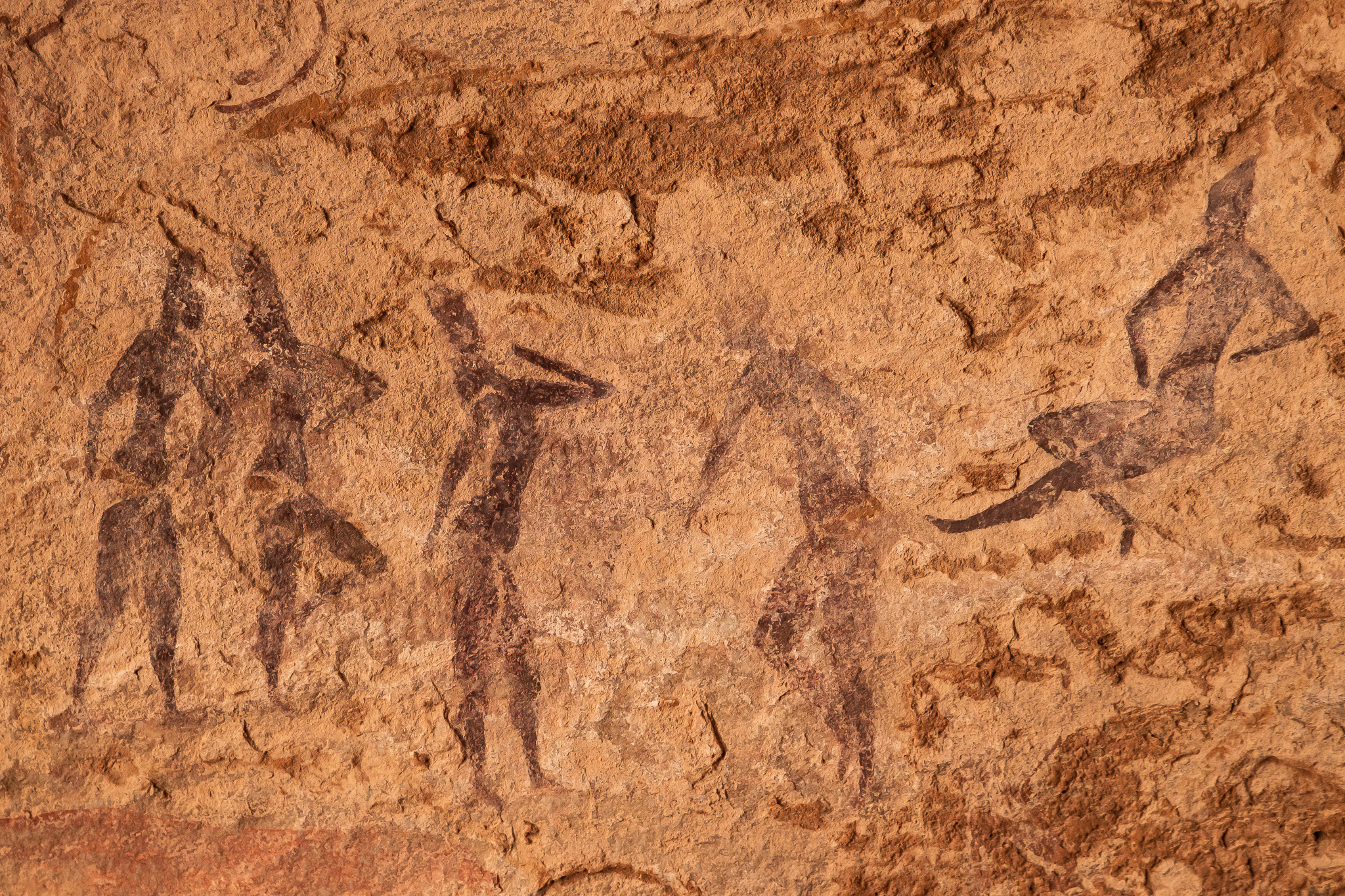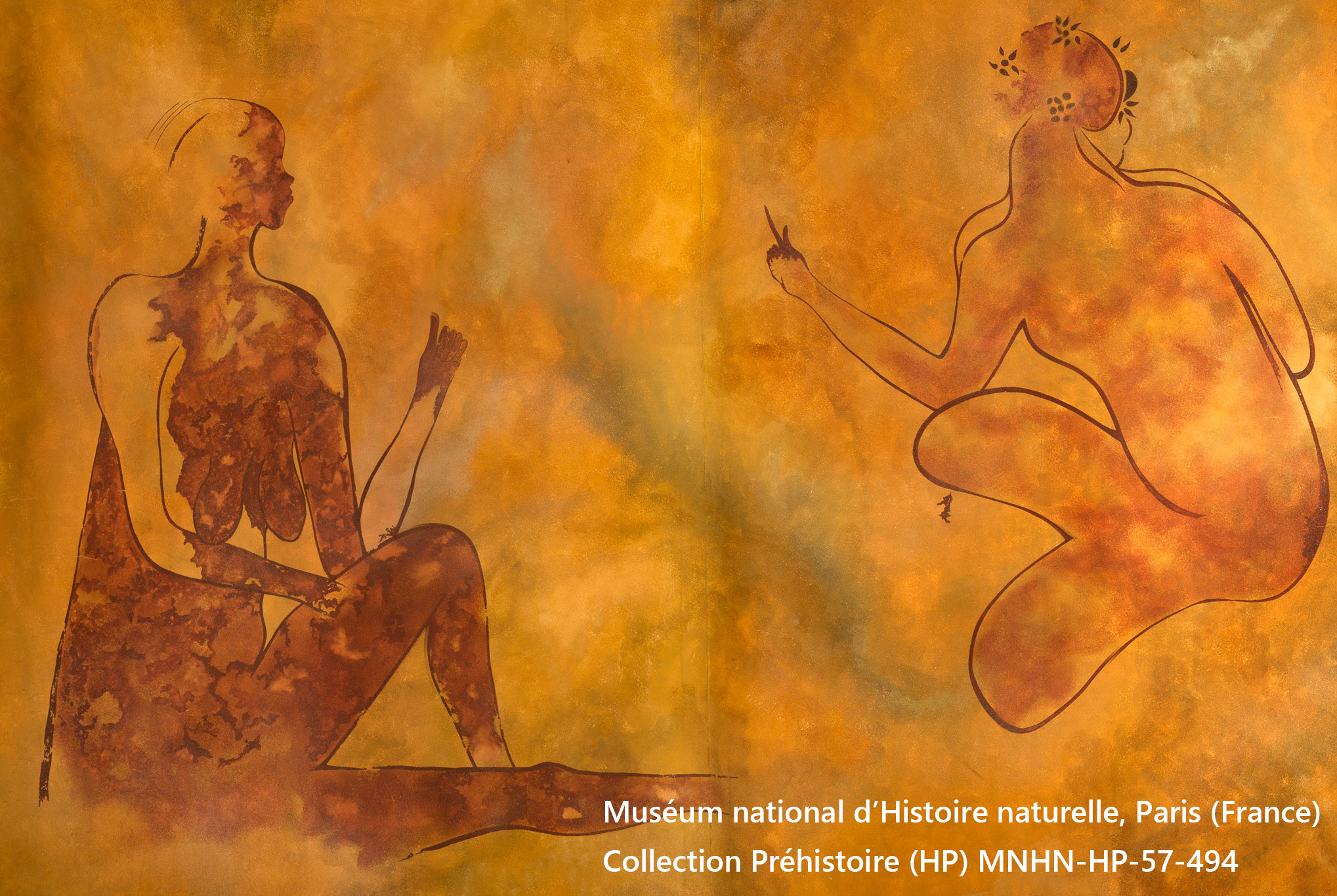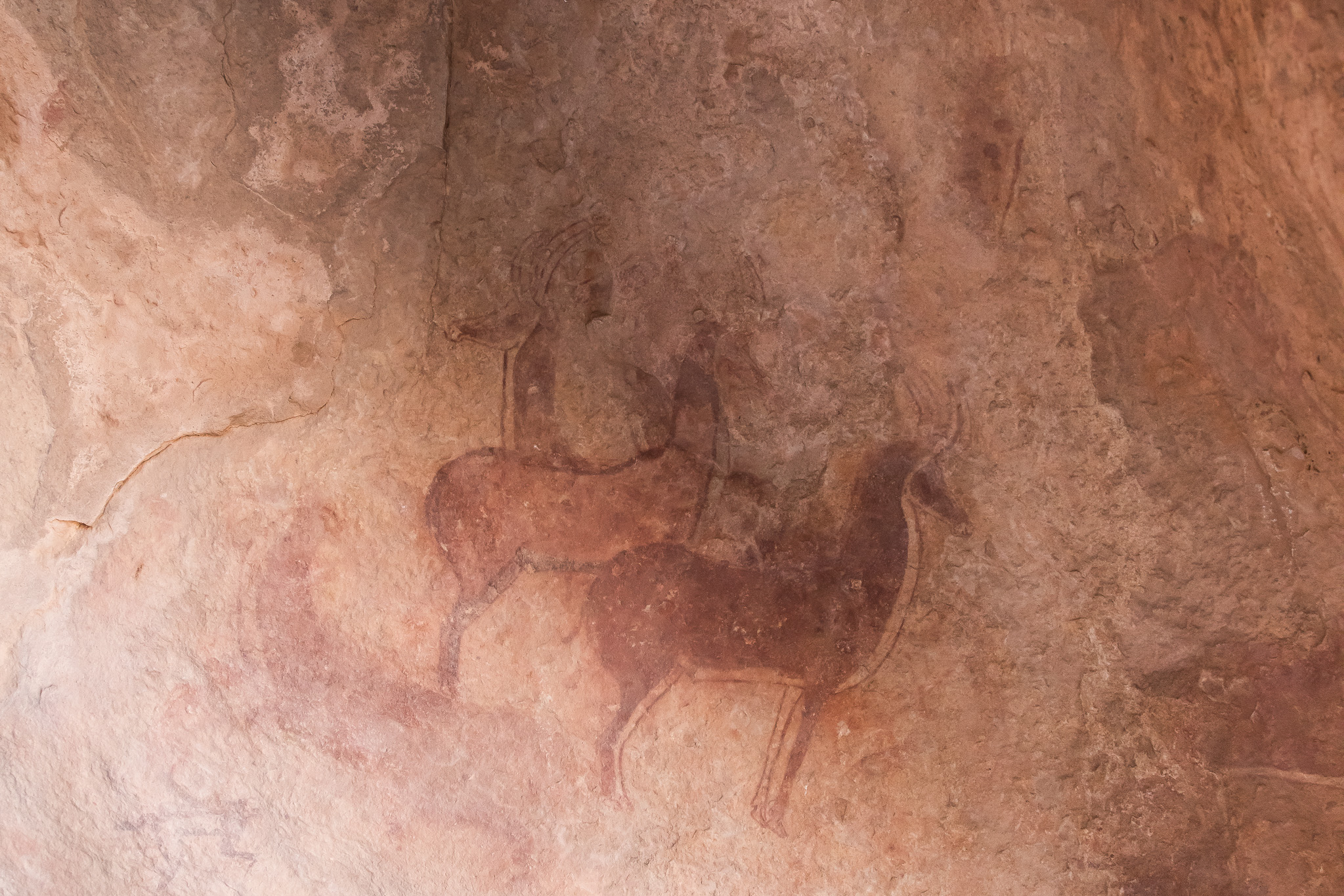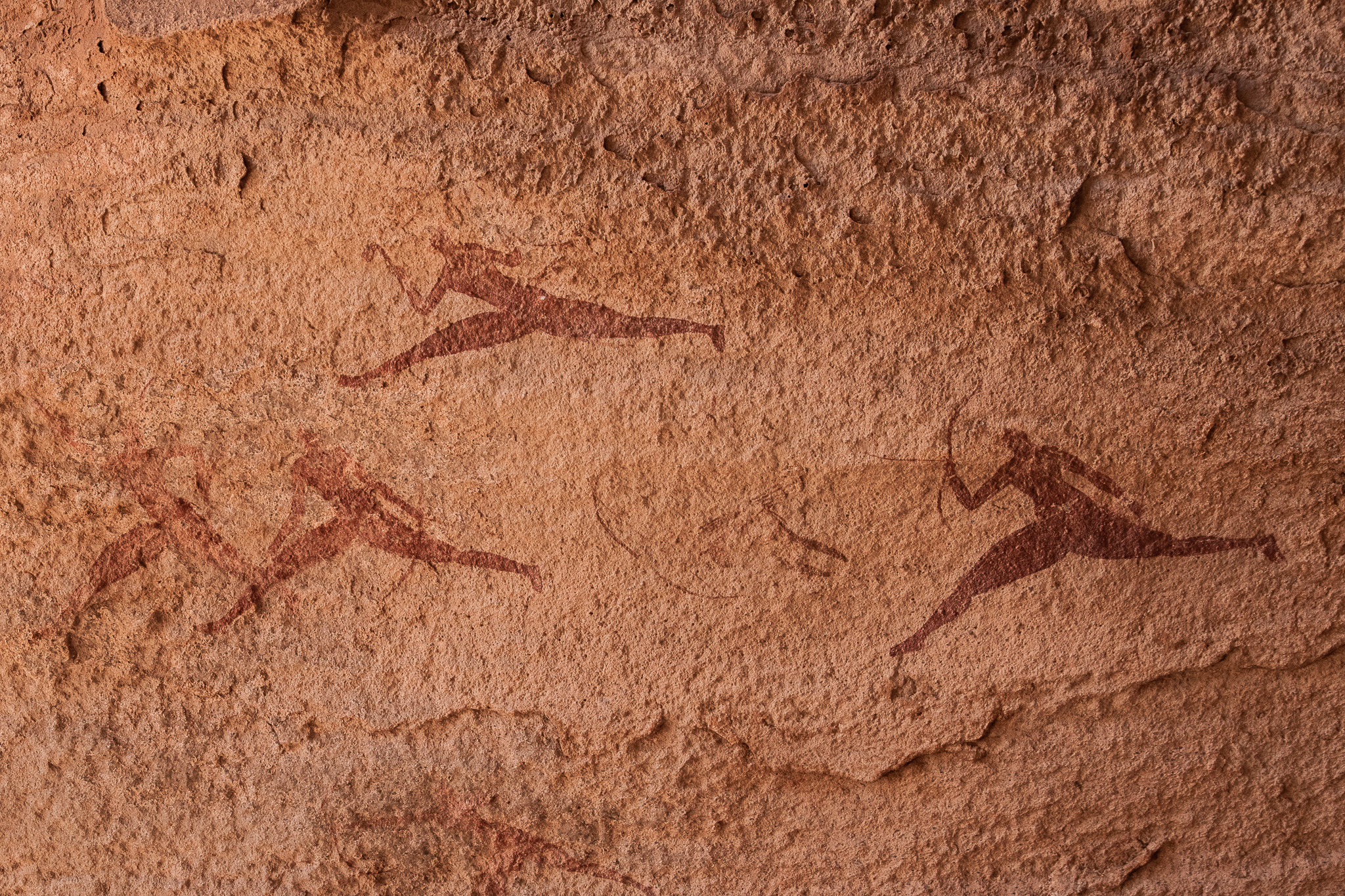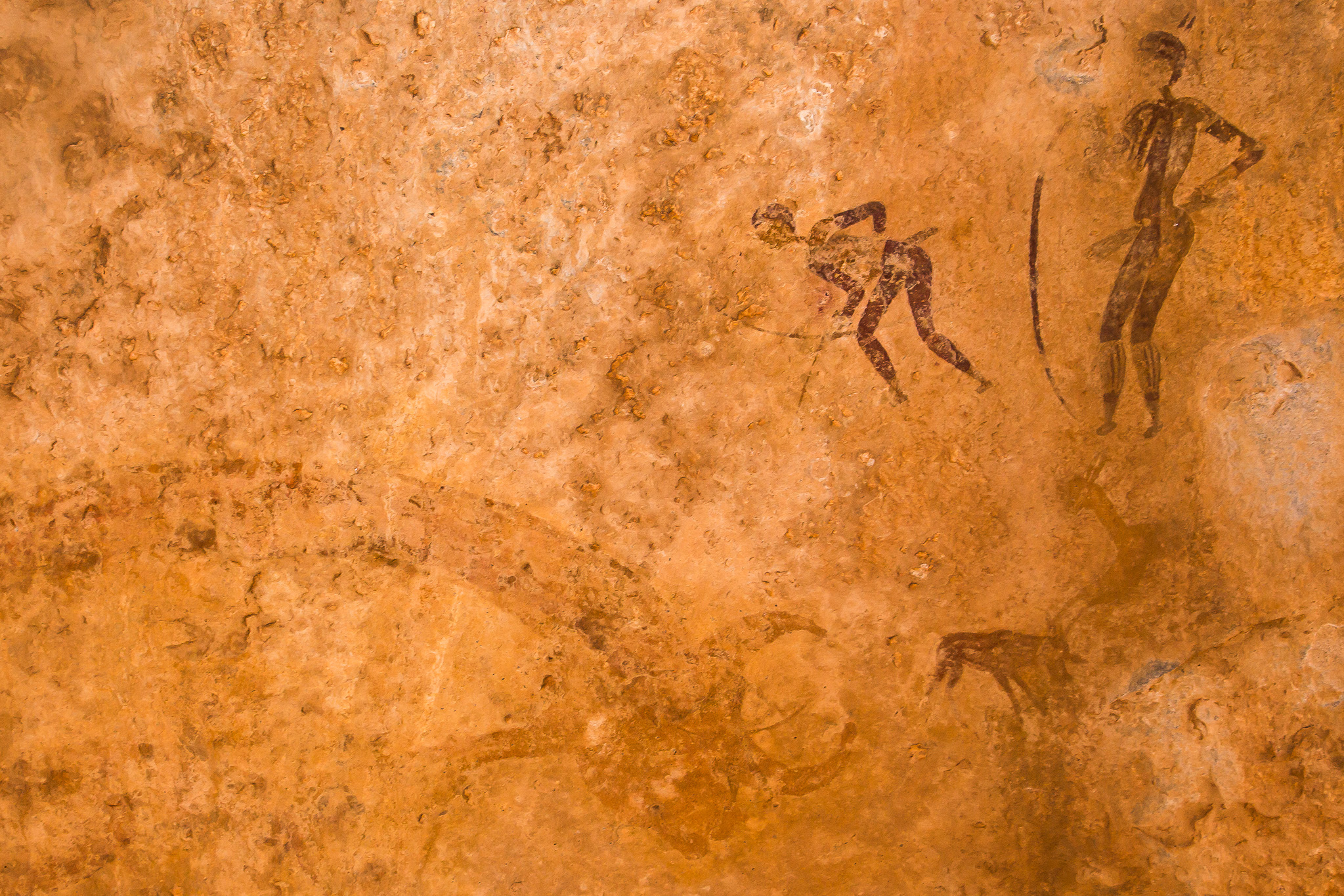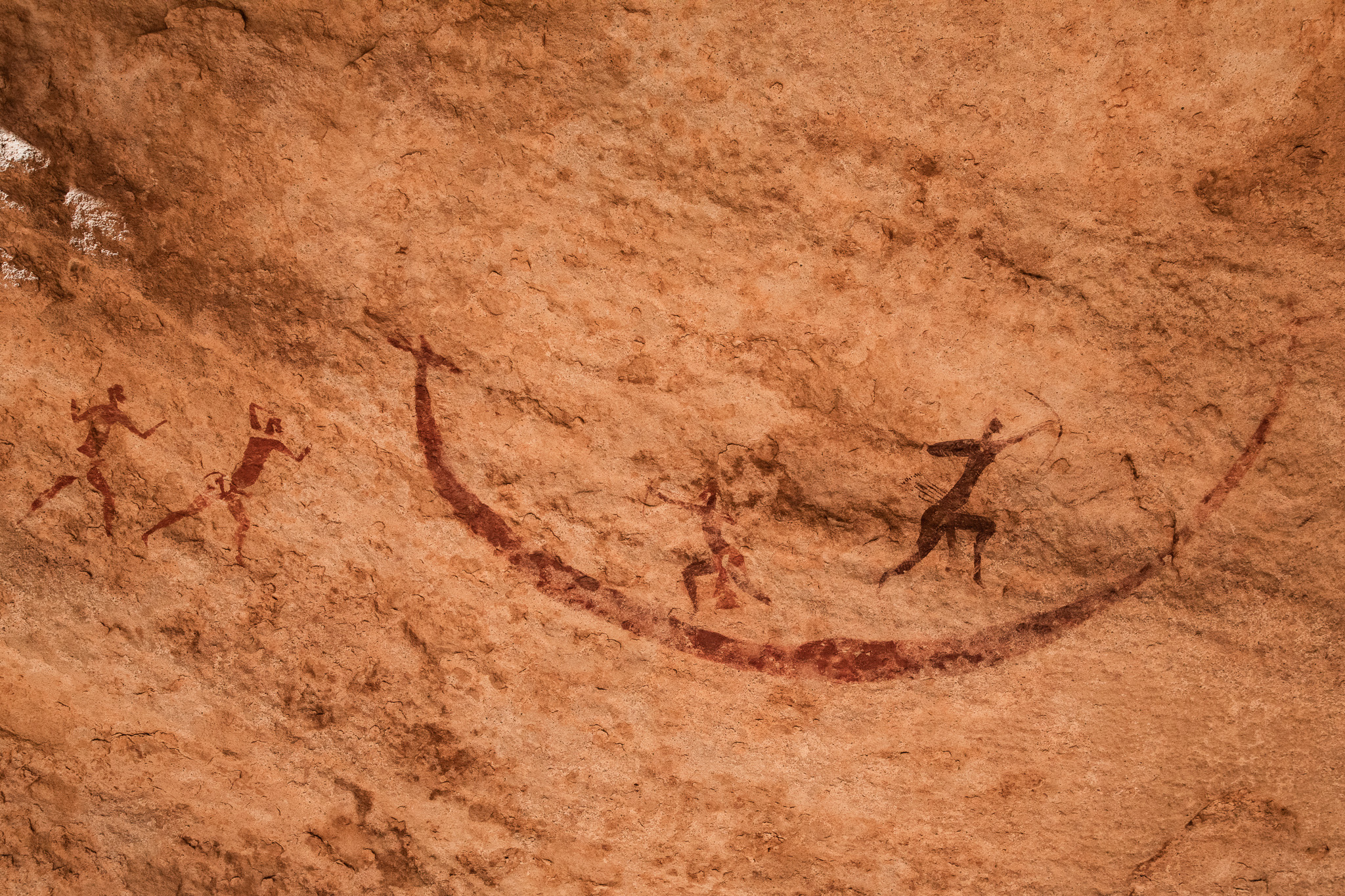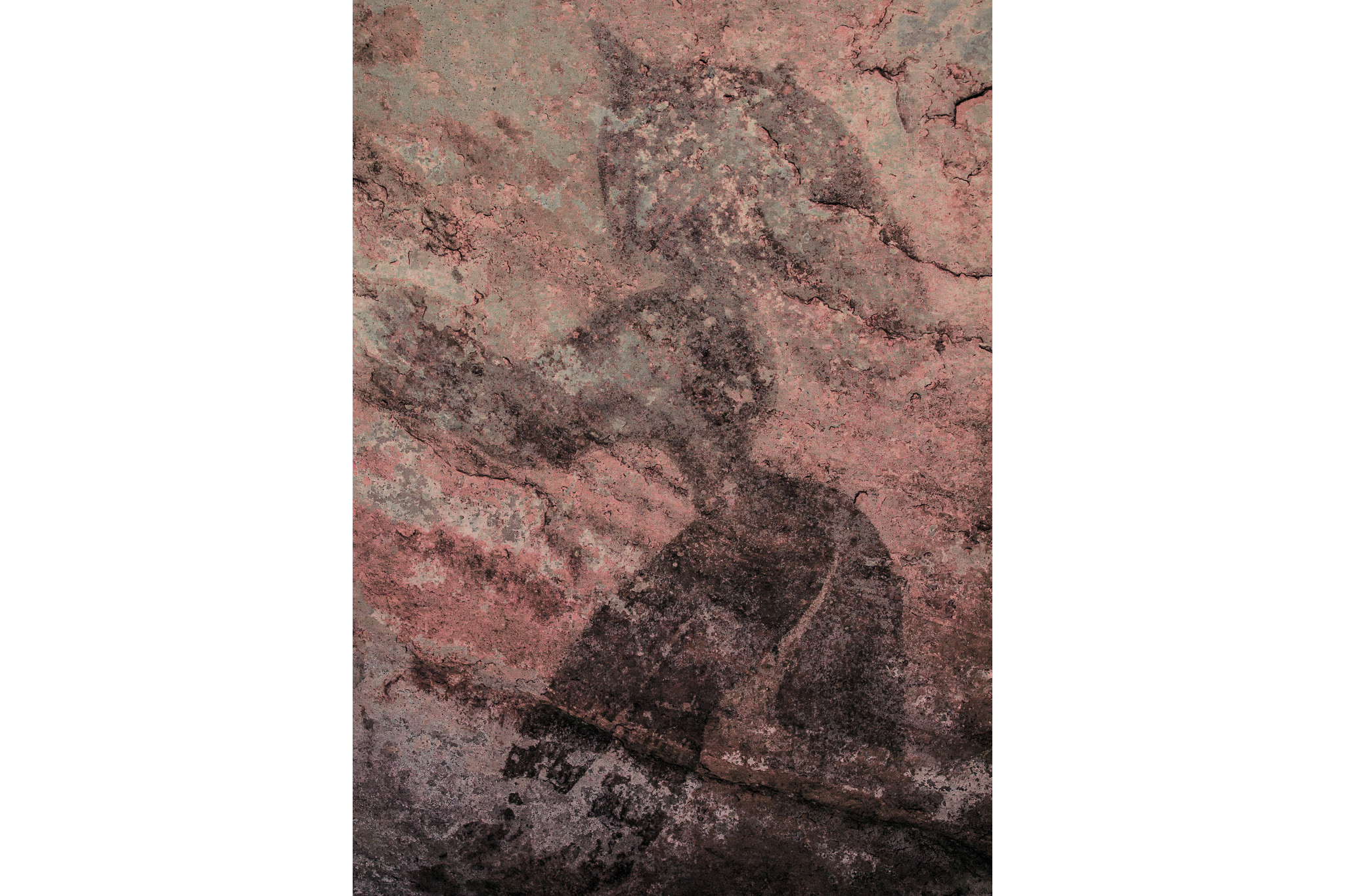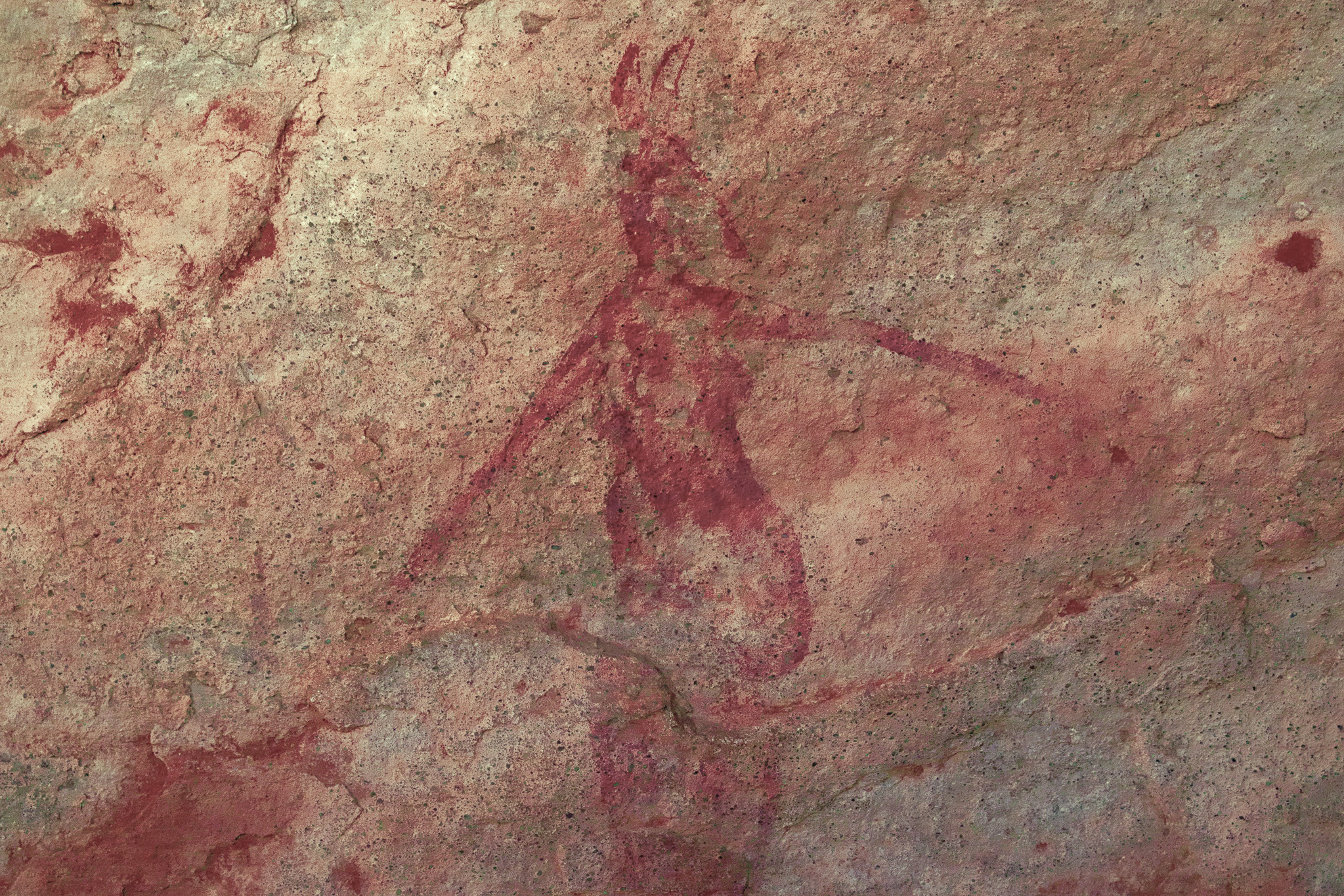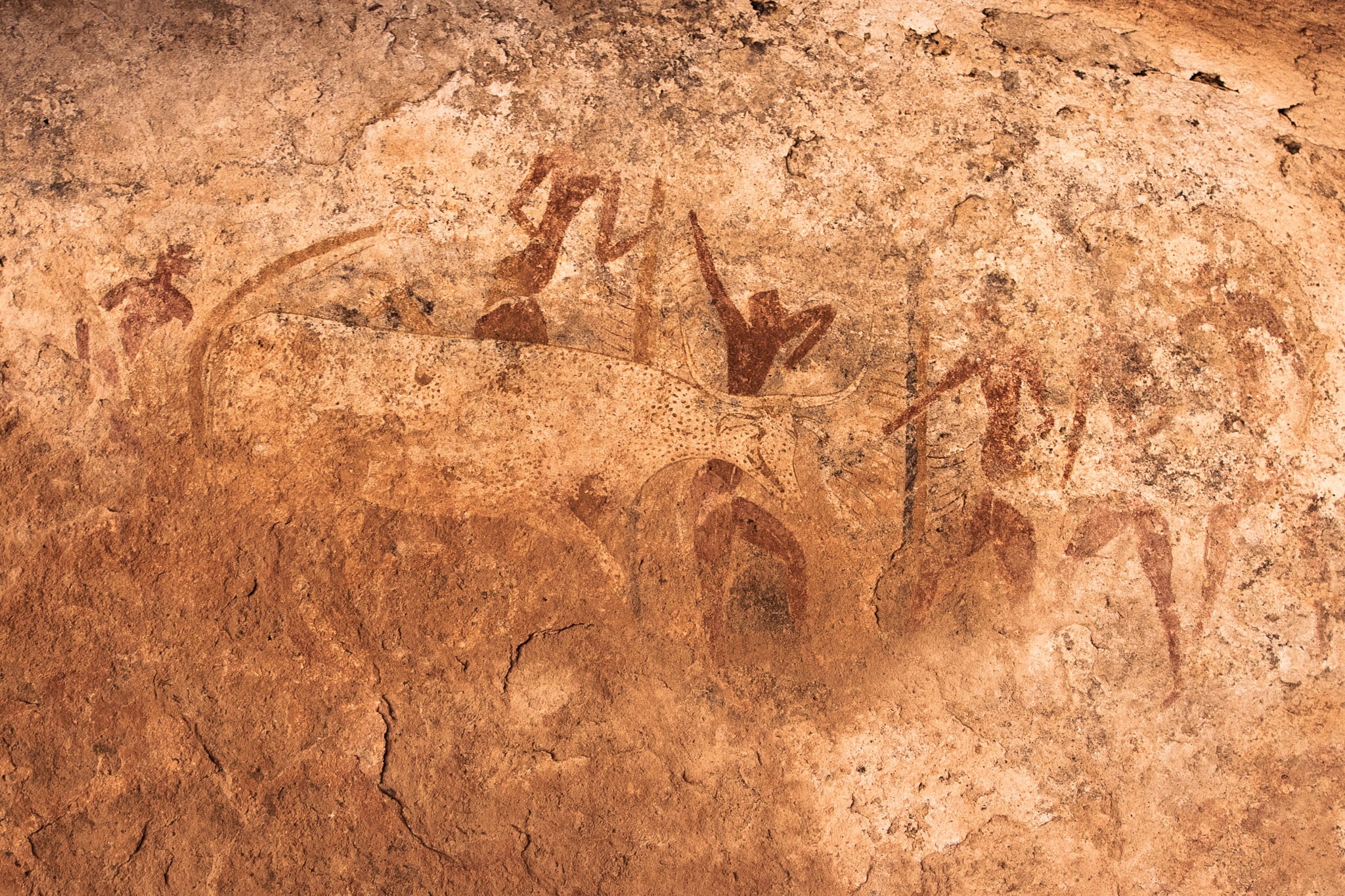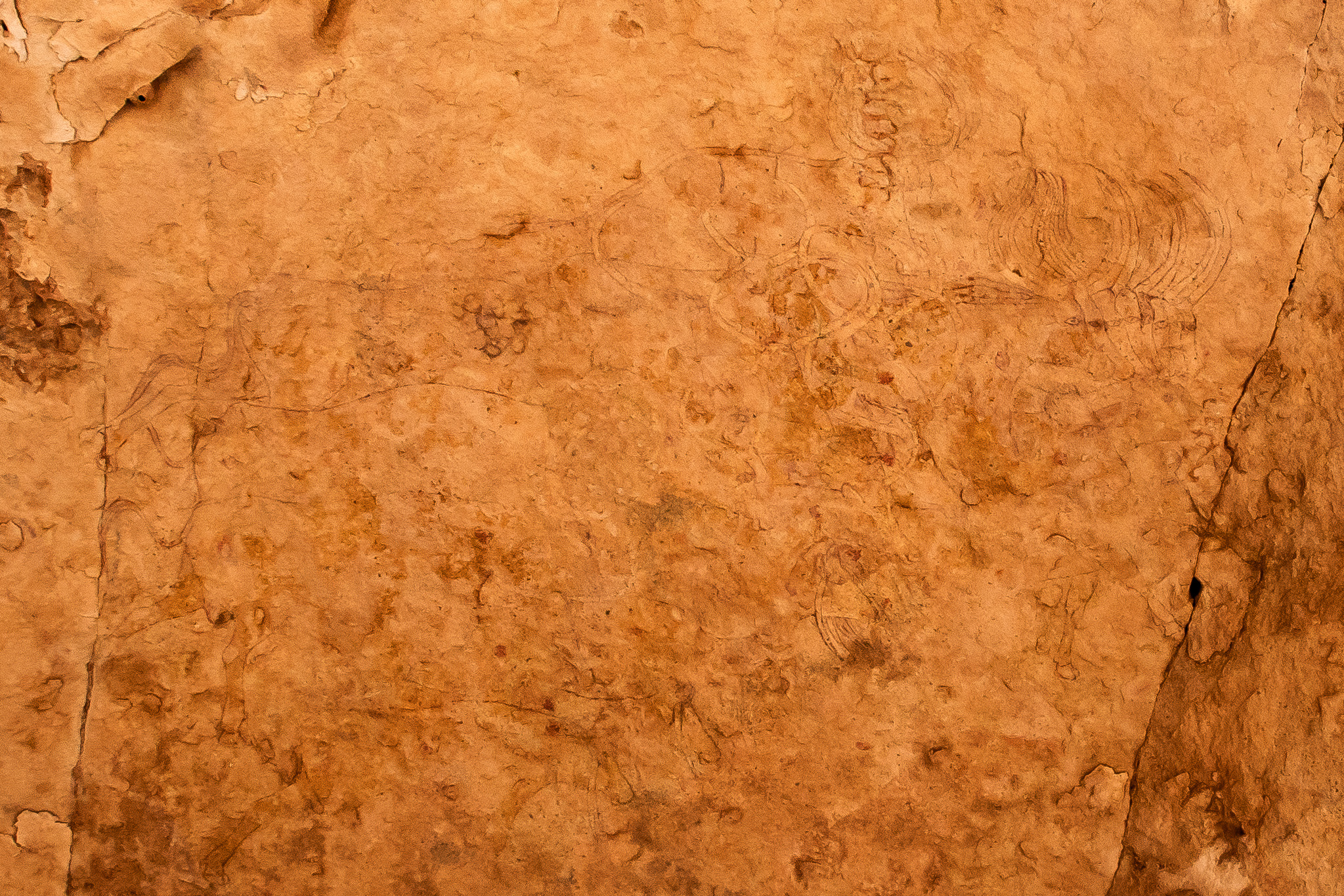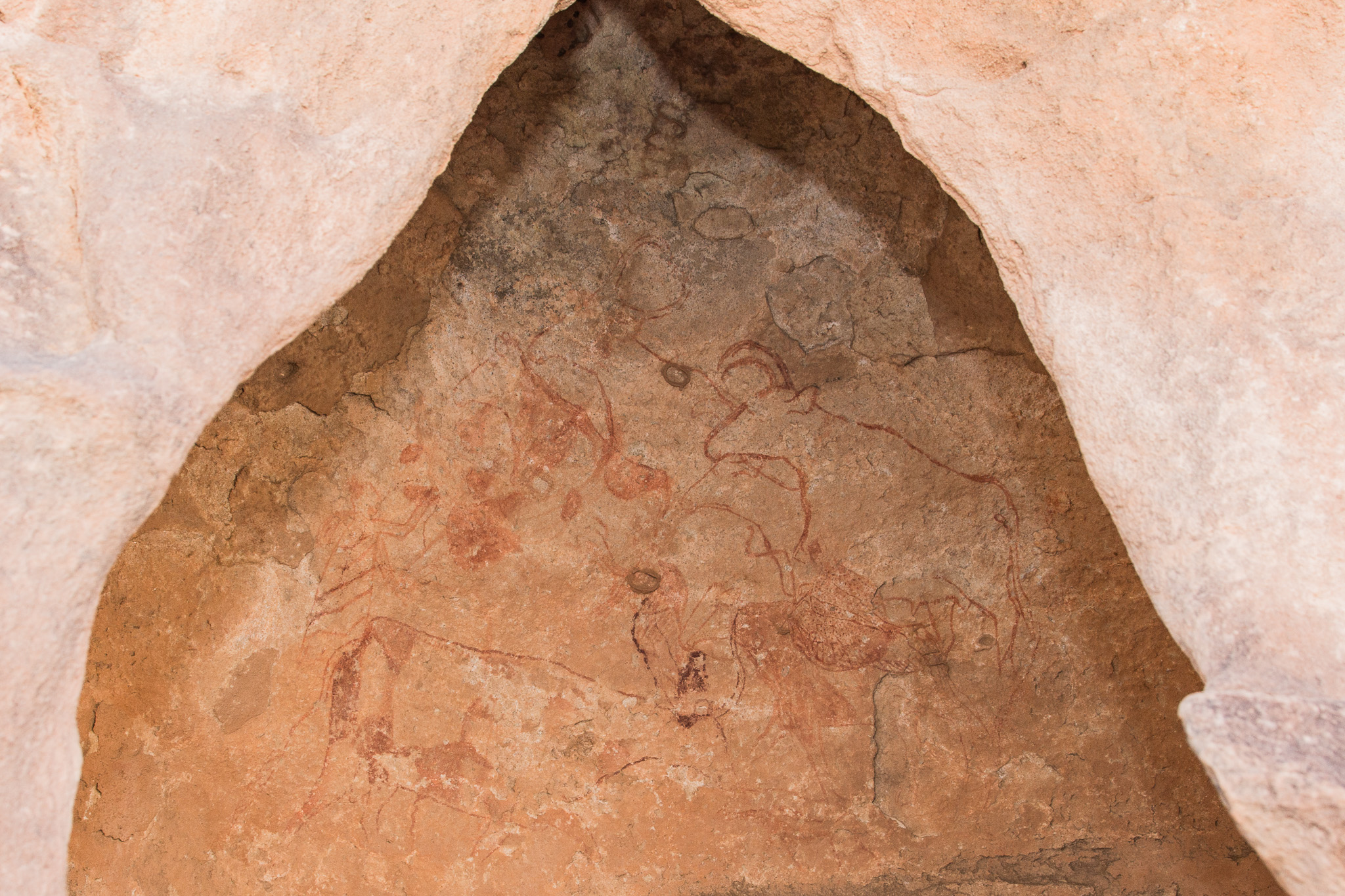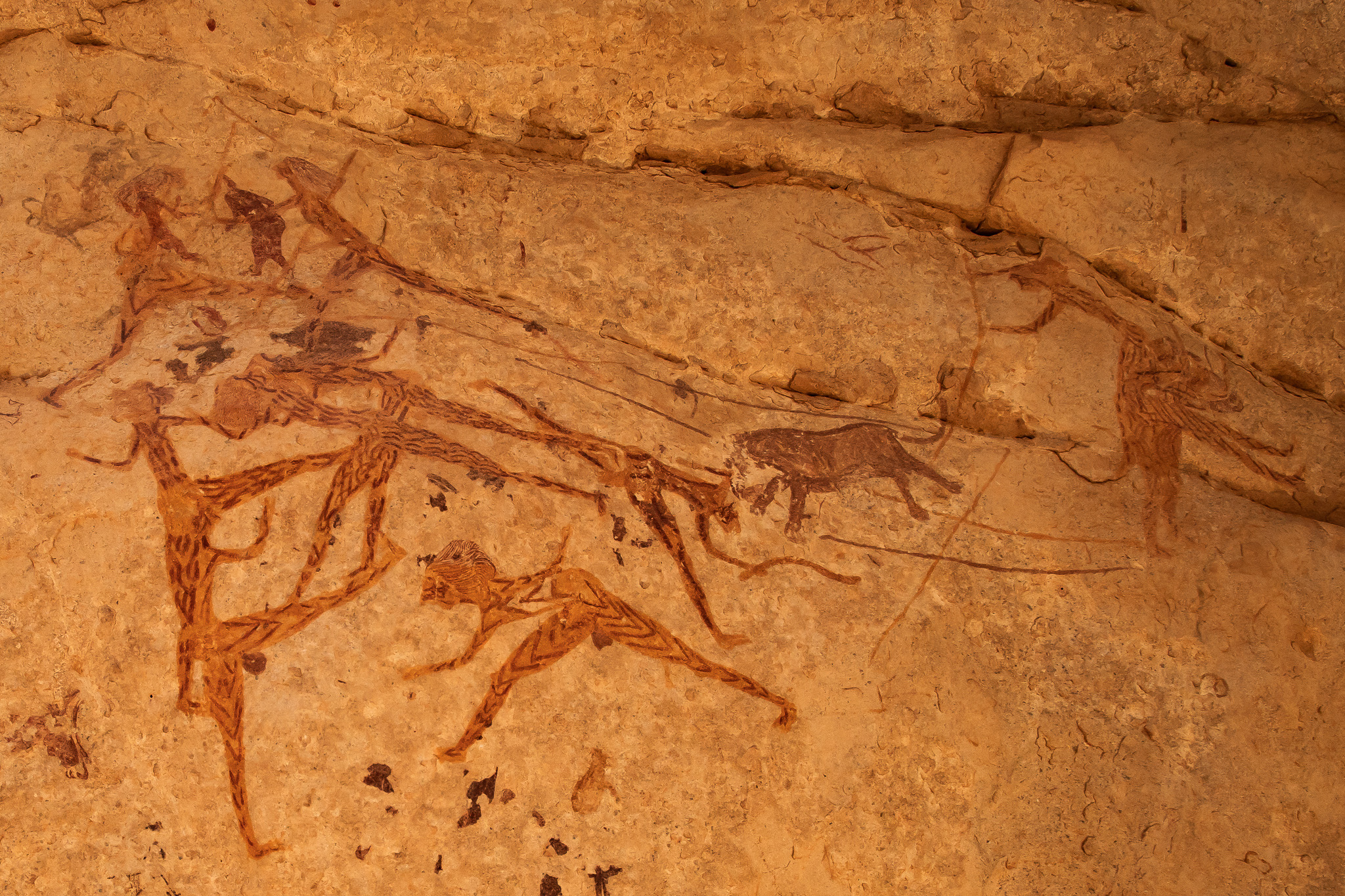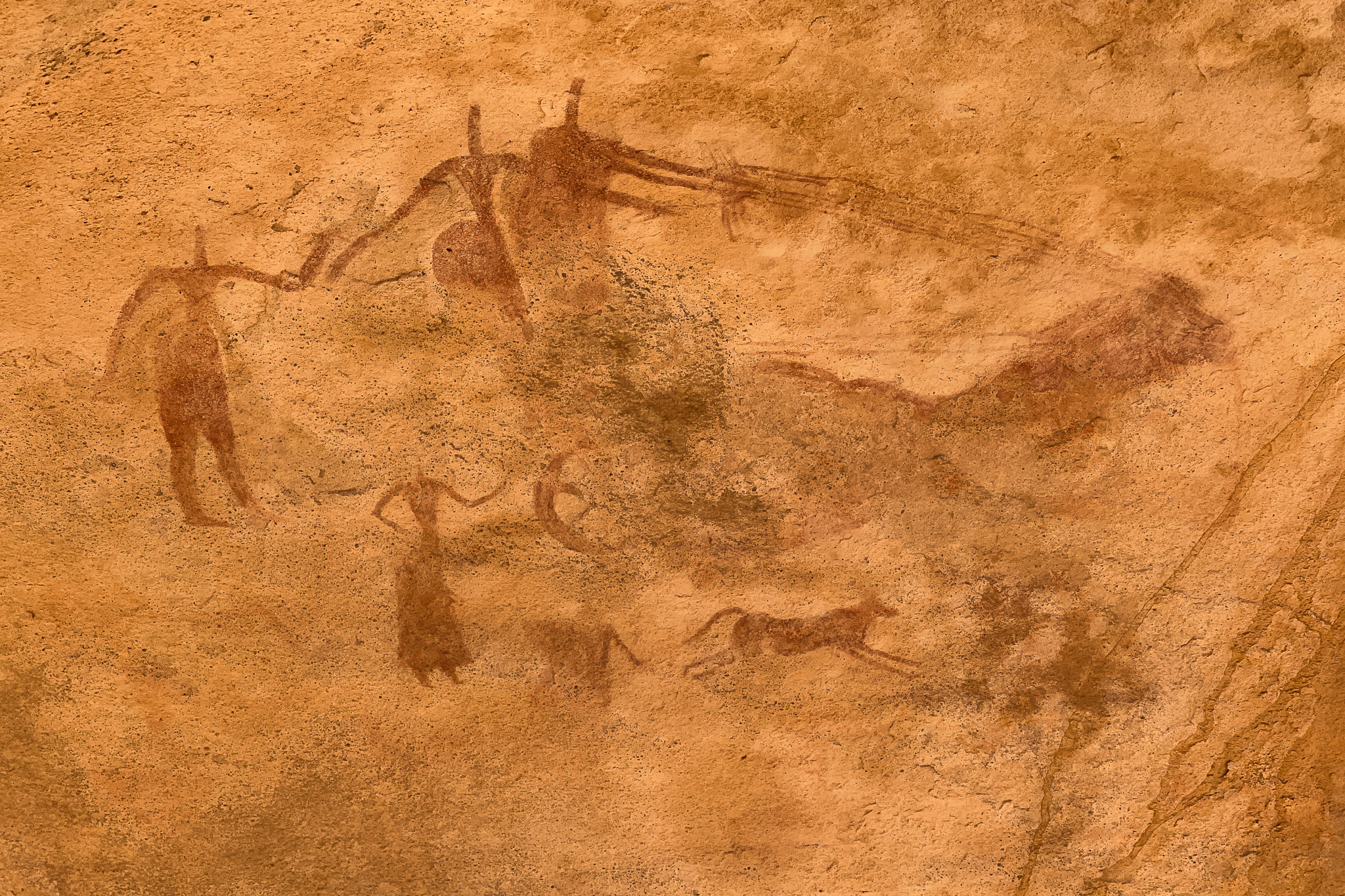After the terrorist attack of January 2013 in the south of Algeria, the Plateau, the main concentration of prehistoric rock art in Tassili n’Ajjer, was completely closed. It was due to the difficulty of border security in the mountainous area located in 40 km from the Libyan border. The Plateau region was reopened this year to foreigners after 10 years with a two-year trial period for domestic tourists.
The Henir Lhote’s exploration team produced about 1000 life-size rock art replicas of Tassili n’Ajjer. The purpose of this trip was to visit these sites and to record the locations and current status. Many of the places have been forgotten, places off the tourist routes or have become unaccounted for because the paintings are almost invisible due to fading and/or filming. Fewer and fewer guides know about these places.
Fortunately, we were able to obtain detailed maps of five sites produced by the Lhote’s team. The Sefar map of the first exploration in 1956 seems to have been made by foot measurements and is not so accurate, but the four other maps made by the 1960-62 teams are very accurate and they are exactly same as the satellite photographs. The locations of these rock art were recorded on GPS maps to serve as a guide.
The route includes 624 places of replicas produced by Lhote, of which 384, being 62%, were identified. Many of the concerned rock paintings were almost invisible and it was a difficult and a time consuming work to identify. (trip in October 2022)
日本人の犠牲者も出た2013年1月のテロ事件以降、タッシリの中で主要な先史壁画が集中するプラトー(Plateau=台地)が閉鎖された。プラトー地域はリビア国境まで約40kmにあって山岳地帯のため国境警備が困難なことからの決定であった。そのプラトー地域が2年間の国内観光客への試行期間を経てようやく外国人に対しても再開された。
アンリ・ロート調査隊(1956-70)はタッシリで約1000点の実物大の模写を制作したが、今回の旅ではそれらの壁画を訪れ、場所と現状を記録することが最大の目的。ロート隊が模写を制作した場所の多くは忘れ去られている。観光ルートから外れたり、退色や塵埃の付着で壁画がほとんど見えなくなって所在不明になったものが多い。これらの場所を知るガイドも少なくなってきている。記録を残しておくことは将来の壁画保護や研究のために必要なことだ。
幸いなことに、ロート隊が作成した詳細な地図を5か所分入手できた。今回はその内4か所を訪ねた。1956年の初回調査のSefarの地図は歩測で作成したようで正確でないところもあるが、60-62年の調査隊が作成した地図4点は衛星写真と寸分違わない正確さで、測量技師の手によるものと思われる。これらの壁画の位置をGPSにプロットして、ガイド替わりの道案内とした。
今回のルートには、ロート隊が描いた模写の場所が624あり、その内384か所、62%の場所が特定できた。ほとんど見えなくなっている壁画が多く、帰国後に鮮明化の画像処理をして合致する模写を探し出す作業に多くの時間を取られた。今後もこの調査を継続することが重要だ。(2022年10月旅行)
PANORAMIC PHOTOS パノラマ写真
Other panoramic photos of Tassili n’Ajjer are available. 前回までに撮影したタッシリのパノラマ写真はこちらです: https://hanafusa.info/project/saharan-rock-art/
| Sheclter of Amazones, Sefar, October 2022 (9.0m x 4.0m) | |
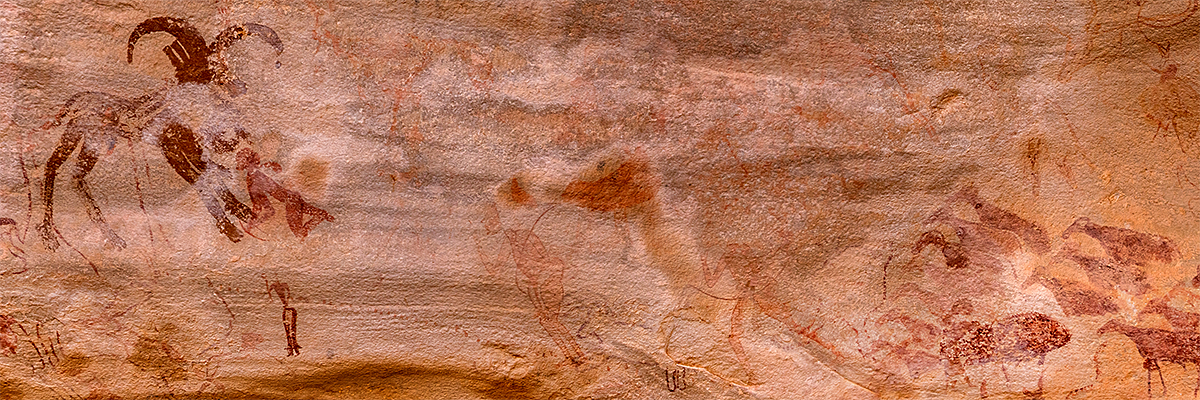 |
|
| アマゾネスの岩陰, セファール 2022年10月 (9.0m x 4.0m) |
| Shelter of Lion Circus, Sefar, October 2022 (4.9m x 3.2m) | |
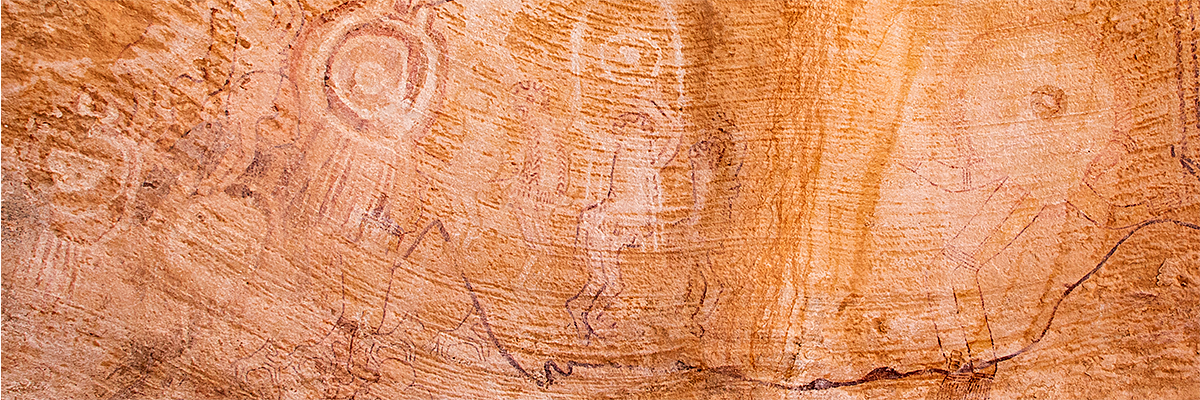 |
|
| ライオンサーカスの岩陰, セファール 2022年10月 (4.9m x 3.2m) |
| Exodus, In-Itinen, October 2022 (2.8m x 2.1m) | |
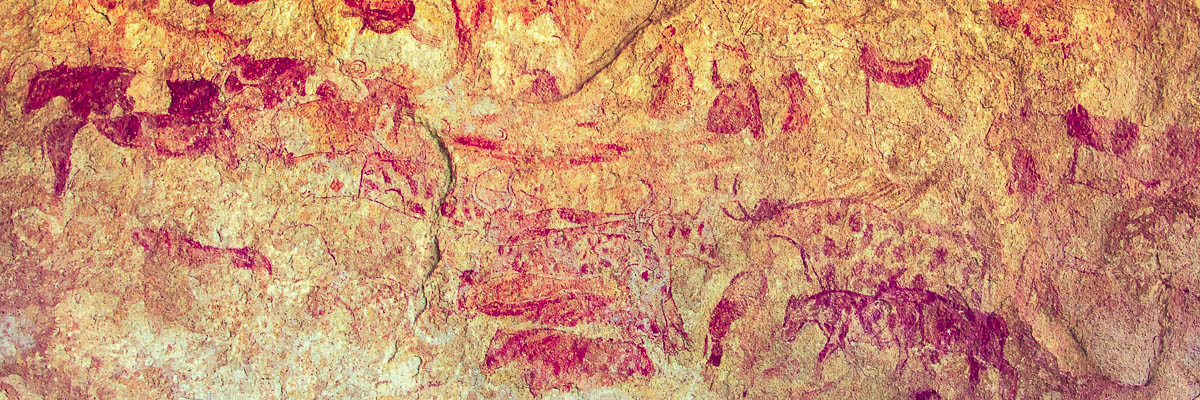 |
|
| 出エジプト, イン・イティネン 2022年10月 (2.8m x 2.1m) |
| Tin Hanakaten,October 2022 (1.6m x 0.6m) | |
 |
|
| ティン・ハナカテン, 2022年10月撮影 (1.6m x 0.6m) |
The life-size replicas of Henri Lhote were exhibited first in Paris in November 1957 and Lhote received a worldwide acclaim. At the exhibitions in Japan, about 100 replicas were shown in Tokyo and in Osaka in 1964. Despite the success, however, the methods used to produce the replicas have been criticised. In the case of rock art that are difficult to see, (A) Wetting the wall to reveal the painting. (B) Outlining with charcoal of the figures revealed by the wetting. (D) Tracing on a tracing paper of the charcoal lines. (E) Copy on a tracing paper of the charcoal lines delimiting the figures on the wall. (E)Transferring the tracings from the tracing paper to the background paper. In addition to damaging the rock art itself, a charcoal traced rock art is not measurable due to carbon contamination, even when the organic binders can be dated.
Charcoal lines on the rock art were washed off after tracing, but in some cases they were forgotten to be washed off and left in place. Unfortunately, an example of this was identified in Ouan Agouba. Charcoal left for long periods of time is fixed and remains.
There was another problem with the replicas produced by the Lhote’s team. That is the problem of the two forgeries made by the team members to deceive Lhote. Forced to make the replicas a prolonged and difficult environment, while Lhote was in Paris, the members created two paintings of Egyptian style as Lhote strongly believed Egyptian influence in some Tassili paintings. It could not be claimed to be a forgery because Lhote saw it and believed it to be genuine, and it was treated as a masterpiece for the exhibition as well as for his books. For this reason, some people criticize Lhote, saying that his members are depicting things that do not exist, or they are imaginatively adding what they cannot see.
Even if there were problems with the method of producing the replicas, it is difficult to see any problems with the replicas themselves, with the exception of these two forgeries. Even when wetted with water, the invisible parts are depicted as invisible parts. This time, we found a subject which was misaligned with the real wall. Many of the traced subjects were brought back to Paris to finish compositions. It is not surprising that such mistakes were made and not an essential problem.
Nowadays, it is not allowed to wet the wall. Instead, DSTRETCH, a enhancing software specially designed for rock paintings, is used. It amplifies the colour gamut of the pigments left on the wall. Some of them work well, but in many cases it cannot be better than the wetting technics. The Lhote team’s replicas are still a valuable source of information, showing what is no longer visible to the naked eye or to DSTRETCH.
ロート隊の実物大模写は、1957年11月にパリで展示されると世界的な反響を得た。日本でも1964年に東京と大阪で約100点の模写が展示された。しかし、賞賛される一方で模写制作の手法が批判されている。見えにくい壁画の場合、(A)水を含んだスポンジで表面を濡らす(あるいは表面の汚れを洗い落とす)、(B)壁画の上に木炭画に使う木炭で直接輪郭線を描く、(D)トレーシングペーパーを押し当ててトレース(木炭の線を転写)、(E)背景が描かれている画用紙に輪郭線をトレース(再転写)する。
壁画上にある木炭の線は、トレース(転写)後に洗い流されていたが、洗い忘れてそのまま残されているケースもあった。今回は残念なことにその例が確認された。長期間残った木炭は固定されて残り続ける。「壁画研究者は腰に霧吹きをぶら下げていた」といった証言もあり、水で濡らすのは当時では許される範囲だったかも知れない。しかし、壁面をこすって洗ったり、木炭で輪郭をなぞるなどは当時でも許される範囲だったかは疑問が残る。木炭でなぞられた壁画は、壁画自体を傷つけることに加えて、将来微量の有機接着剤の年代測定が可能となっても炭素汚染のため測定てきない。
ロート隊の制作した模写にはもうひとつの問題があった。それは、隊員がロートを欺くために作った偽作の問題だ。長期間に及ぶ厳しい環境で模写制作を強いられた隊員が、パリ滞在で不在のロートに対するいたずらで、彼の強調するエジプトの影響を示す絵をでっち上げた。これを見たロートが本物と信じてしまったため偽作とは言い出せず、模写展やロートの著作を飾るものとして扱われてしまった。このため、「ロート隊の制作した模写には存在しないものが描かれている。見えないところを想像で描き足している」と批判する人もいる。
模写制作方法に問題があったとしても、模写自体については偽作2点を除いて問題があるとは考えにくい。水で濡らしても見えない部分は見えない部分として描かれている。今回、題材の位置が実物とずれているものがあった。トレースした題材を部品としてパリに持ち帰って仕上げたものも多く、こうしたミスはあっても不思議ではなく、本質的な問題とは言えない。
現在は水で濡らすことは許されず、替わりにDSTRETCHという壁画専用の鮮明化ソフトが使われる。壁面に残された顔料の色域を増幅するものだが、その効果があるものとないものがある。残念ながら水で濡らした鮮明度には敵わない場合が多い。ロート隊の模写は、肉眼やDSTRETCHで見えなくなったものを見せてくれる貴重な資料だ。また、過酷な環境で何カ月もかけて制作されたものであり、制作者たちの労苦に感謝して鑑賞したい。

